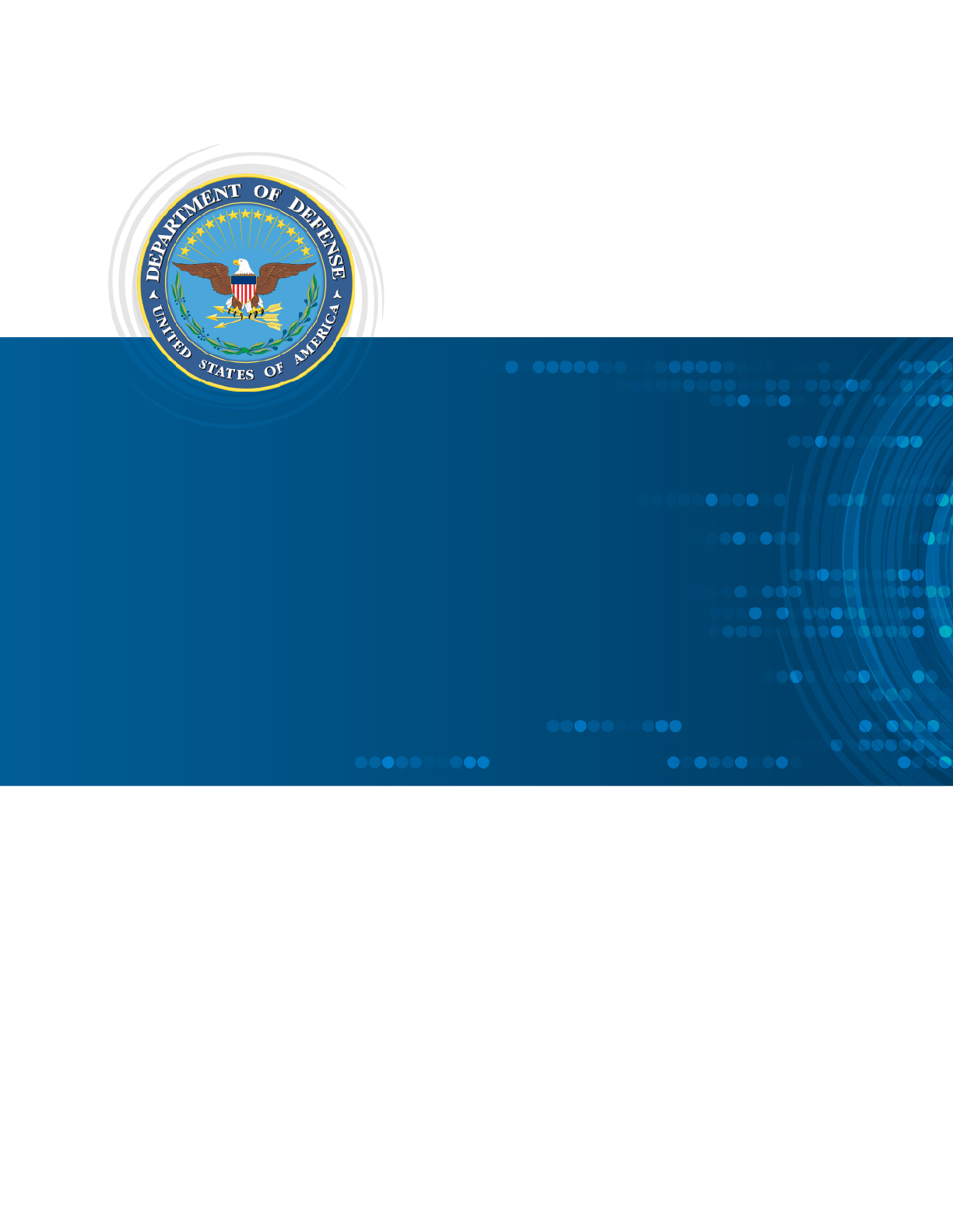
UNCLASSIFIED
1
Unclassified
Sept
ember 2021
Version 2.1
Unclassified
DISTRIBUTION STATEMENT A. Approved for public release. Distribution is unlimited.
DoD Enterprise
DevSecOps
Fundamentals
Unclassified
CLEARED
For Open Publication
Department of Defense
OFFICE OF PREPUBLICATION AND SECURITY REVIEW
Oct 19, 2021
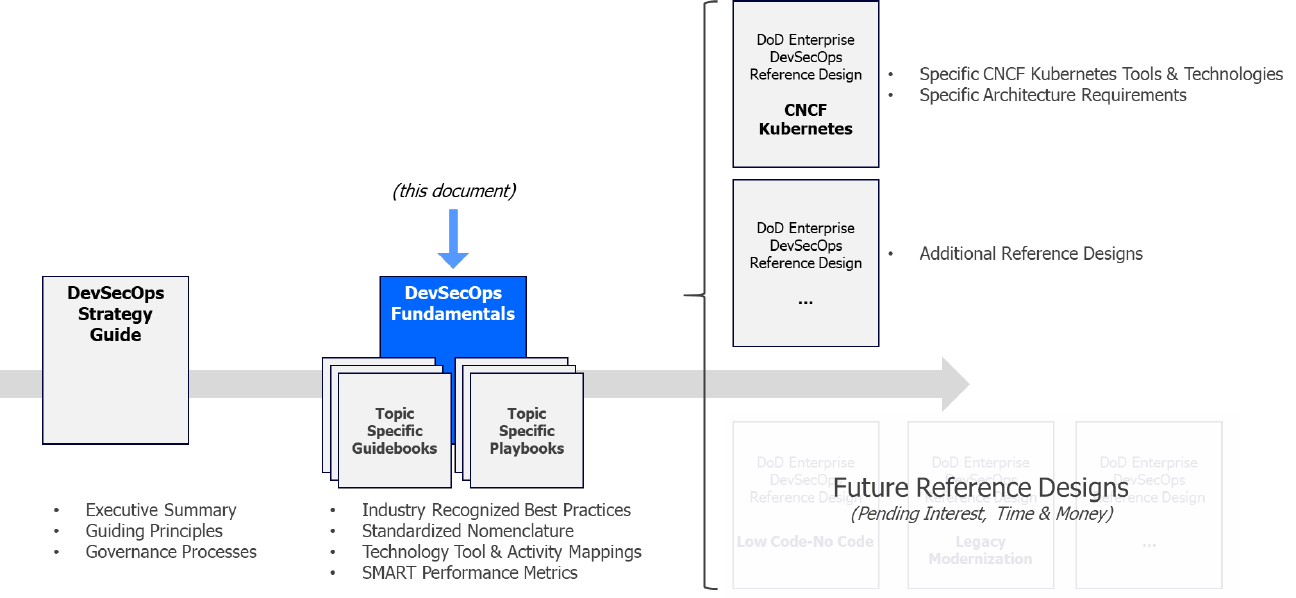
UNCLASSIFIED
i
Unclassified
Document Set Reference
UNCLASSIFIED
ii
Unclassified
Document Approvals
________________________________________
Approved by:
John B. Sherman
Chief Information Officer of the Department of Defense (Acting)
Approved by:
________________________________________
Stacy A. Cummings
Under Secretary of Defense for Acquisition and Sustainment (Acting)
UNCLASSIFIED
iii
Unclassified
Trademark Information
Names, products, and services referenced within this document may be the trade names,
trademarks, or service marks of their respective owners. References to commercial vendors and
their products or services are provided strictly as a convenience to our readers, and do not
constitute or imply endorsement by the Department of any non-Federal entity, event, product,
service, or enterprise.
UNCLASSIFIED
iv
Unclassified
Contents
1 Introduction ......................................................................................................................... 1
2 Agile .................................................................................................................................... 2
2.1 The Agile Manifesto ..................................................................................................... 2
2.2 Psychological Safety .................................................................................................... 2
3 Software Supply Chains ...................................................................................................... 3
3.1 Value of a Software Factory ......................................................................................... 3
3.2 Software Supply Chain Imperatives ............................................................................. 7
3.2.1 Development Imperatives ..................................................................................... 7
3.2.2 Security Imperatives ............................................................................................. 7
3.2.3 Operations Imperatives ......................................................................................... 8
4 DevSecOps ........................................................................................................................10
4.1 DevSecOps Overview .................................................................................................10
4.2 DevSecOps Culture & Philosophy ...............................................................................12
4.2.1 DevSecOps Cultural Progression.........................................................................13
4.3 Zero Trust in DevSecOps ............................................................................................14
4.4 Behavior Monitoring in DevSecOps ............................................................................14
5 DevSecOps Lifecycle .........................................................................................................15
5.1 Cybersecurity Testing at Each Phase .........................................................................16
5.2 Importance of the DevSecOps Sprint Plan Phase .......................................................17
5.3 Clear and Identifiable Continuous Feedback Loops ....................................................18
5.3.1 Continuous Build ..................................................................................................18
5.3.2 Continuous Integration .........................................................................................18
5.3.3 Continuous Delivery .............................................................................................19
5.3.4 Continuous Deployment .......................................................................................20
5.3.5 Continuous Operations ........................................................................................20
5.3.6 Continuous Monitoring .........................................................................................21
6 D
evSecOps Platform .........................................................................................................21
6.1 DevSecOps Platform Conceptual Model .....................................................................24
7 Current and Envisioned DevSecOps Software Factory Reference Designs .......................25
7.1 CNCF Kubernetes Architectures .................................................................................25
7.2 CSP Managed Service Provider Architectures ............................................................25
7.3 Low Code/No Code and RPA Architectures ................................................................26
7.4 Serverless Architectures .............................................................................................26
UNCLASSIFIED
v
Unclassified
8 Deployment Types .............................................................................................................26
8.1 Blue/Green Deployments ............................................................................................26
8.2 Canary Deployments ..................................................................................................27
8.3 Rolling Deployments ...................................................................................................27
8.4 Continuous Deployments ............................................................................................27
9 Minimal DevSecOps Tools Map .........................................................................................28
9.1 Architecture Agnostic Minimal Common Tooling .........................................................28
10 Measuring Success with Performance Metrics ...............................................................30
11 DevSecOps Next Steps ..................................................................................................32
Appendix A Acronym Table .....................................................................................................33
Appendix B Glossary of Key Terms ........................................................................................36
Figures
Figure 1 Notional Software Supply Chain ................................................................................... 4
Figure 2 Normative Software Factory Construct ......................................................................... 5
Figure 3 Maturation of Software Development Best Practices ...................................................10
Figure 4 DevSecOps Distinct Lifecycle Phases and Philosophies .............................................11
Figure 5 "Unfolded" DevSecOps Lifecycle Phases ....................................................................15
Figure 6 Notional expansion of a DevSecOps software factory with illustrative list of tests .......16
Figure 7 Control Gate Goals .....................................................................................................17
Figure 8 Continuous Build Feedback Loop ................................................................................18
Figure 9 Continuous Integration Feedback Loop .......................................................................19
Figure 10 Continuous Delivery Feedback Loop .........................................................................19
Figure 11 Continuous Deployment Feedback Loop ...................................................................20
Figure 12 Continuous Operations Feedback Loop ....................................................................20
Figure 13 Continuous Monitoring Phase and Feedback Loop ...................................................21
Figure 14 Notional DevSecOps Platform with Interconnects for Unique Tools and Activities .....23
Figure 15 DevSecOps Conceptual Model with Cardinalities Defined .........................................24
Figure 16 Notional Hypervisor Construct ...................................................................................40
UNCLASSIFIED
1
Unclassified
1 Introduction
This document is intended as an educational compendium of universal concepts related to
DevSecOps, including normalized definitions of DevSecOps concepts. Other pertinent
information is captured in corresponding topic-specific guidebooks or playbooks. Guidebooks
are intended to provide deep knowledge and industry best practices with respect to a specific
topic area. Playbooks consist of one-page plays, structured to consist of a best practice
introduction, salient points, and finally a checklist or call-to-action.
The intended audience of this document includes novice and intermediate staff who have
recently adopted or anticipate adopting DevSecOps. The associated guidebooks and playbooks
provide additional education and insight. Expert practitioners may find value in this material as a
refresher.
This document and topic-specific guidebooks/playbooks are intended to be educational.
Section 1: Agile principle adoption across the DoD continues to grow, but it is not ubiquitous by
any measure. This document presents an informative review of Agile and agile
principles.
Section 2: Includes a review of software supply chains, focusing on the role of the software
factory within the supply chain, as well as the adoption and application of
DevSecOps cultural and philosophical norms within this ecosystem. Development,
security, and operational imperatives are also captured here.
Section 3: Building on the material covered in sections 1 and 2, this section includes an in-
depth explanation of DevSecOps and the DevSecOps lifecycle to include each
phase and related continuous process improvement feedback loops.
Section 4: Includes current and potential DoD Enterprise DevSecOps Reference Designs. Each
reference design is fully captured in its own separate document. The minimum set of
material required to define a DevSecOps Reference Design is also defined in this
section.
Section 5: Performance metrics are a vital part of both the software factory and DevSecOps.
Specific metrics are as-yet undefined, but pilot programs are presently underway to
evaluate what metrics make the most sense for the DoD to aggregate and track
across its enormous portfolio of software activities. This section introduces a number
of well-known industry metrics for tracking the performance of DevSecOps pipelines
to create familiarity.

UNCLASSIFIED
2
Unclassified
2 Agile
2.1 The Agile Manifesto
The Agile Manifesto captures core competencies that define the functional relationship and what
a DevSecOps team should value most:
1
• Individuals and interactions over processes and tools
• Working software over comprehensive documentation
• Customer collaboration over contract negotiation
• Responding to change over following a plan
T
he use of the phrase over is vital to understand. The manifesto is not stating that there is no
value in processes and tools, documentation, etc. It is, however, stating that these things should
not be emphasized to a level that penalizes the other.
T
he first principle regarding Individuals and interactions over processes and tools explicitly
speaks to DevSecOps. The ability of a cross-functional team of individuals to collaborate
together is a stronger indicator of success than the selection of specific tooling or processes.
This ideal is further strengthened by the 12 principles of agile software, particularly the principle
that reinforces the priority for early and often customer engagement.
2
2.2 Psychological Safety
New concepts inherently come with a degree of skepticism and uncertainty. Within the DoD,
DevSecOps is a new concept, and the entire span of our workforce, from engineering talent, to
acquisition professionals, through our leadership have many questions on this topic. The
success of the commercial industry in using these practices has been widely documented.
3
There are leaders who want DevSecOps, but cannot tell if they are already practicing
DevSecOps, or how to effectively communicate their practices if they do. Acquisition
professionals routinely struggle to understand how to effectively buy services predicated upon
DevSecOps due to the perception that it is hard to put tangible frames around and a price tag
on something seemingly conceptual. Skepticism and uncertainty can also drive undesirable
actions and reactions across the DoD, such as bias and fear. It is human nature to instinctively
fall back on life experiences in an attempt to bring experiential knowledge to an unfamiliar
situation. When this happens, we unknowingly insert bias into decision making processes and
understanding. When this happens, this must be recognized and corrected.
Taxpayers reasonably expect an evaluation of investments, specifically if an appropriate level of
value will be created given the investment of time, resources, and money spent. Across the
1
Beck, K. et. al., 2001. Manifesto for Agile Software Development. [Online]. Available at:
https://agilemanifesto.org.
2
Beck, K. et. al., 2001. Manifesto for Agile Software Development. [Online]. Available at:
https://agilemanifesto.org/principles.html.
3
Defense Innovation Board (DIB), “Software Acquisition and Practices (SWAP) Study.” May 03, 2019,
[Online]. Available: https://innovation.defense.gov/software.

UNCLASSIFIED
3
Unclassified
Department the status quo is too often maintained because of the sunk cost fallacy.
4
The
DevSecOps journey can be a positive transformational journey, but only if we are acutely aware
of bias towards psychological safety when working towards critical decisions.
3 Software Supply Chains
The software supply chain is a logistical pathway that covers the entirety of all the hardware,
Infrastructure as a Service (IaaS), Platform as a Service (PaaS), Software as a Service (SaaS),
technology force multipliers, and tools and practices that are brought together to deliver specific
software capabilities. A notional software supply chain, depicted in Figure 1, is the recognition
that software is rarely produced in isolation, and a vulnerability anywhere within the supply chain
of a given piece of code could create an exposure or worse, a compromise. Hardware,
infrastructure, platforms and frameworks, Software as a Service, technology force multipliers,
and especially the people and processes come together to form this supply chain.
The software supply chain matters because the end software supporting the warfighter, from
embedded software on the bridge of a Naval vessel to electronic warfare algorithms in an
aircraft, is only possible because of the people, processes, and tools that created the end result.
For example, a compiler is unlikely to be deployed onto a physical vessel, but without the
compiler there would be no guidance system. For this reason, the software supply chain must
be recognized, understood, secured, and monitored to ensure mission success.
3.1 Value of a Software Factory
A normative software factory construct, illustrated in Figure 2, contains multiple pipelines,
which are equipped with a set of tools, process workflows, scripts, and environments, to
produce a set of software deployable artifacts with minimal human intervention. It automates the
activities in the develop, build, test, release, and deliver phases. The environments that are set
up in the software factory should be rehydrated using Infrastructure as Code (IaC) and
Configuration as Code (CaC) that run on various tools. A software factory must be designed
for multi-tenancy and automate software production for multiple products. A DoD organization
may need multiple pipelines for different types of software systems, such as web applications or
embedded systems.
4
Arkes, Hal R. & Blumer, Catherine, 1985. "The psychology of sunk cost," Organizational Behavior and
Human Decision Processes, Elsevier, vol. 35(1), pages 124-140, February.
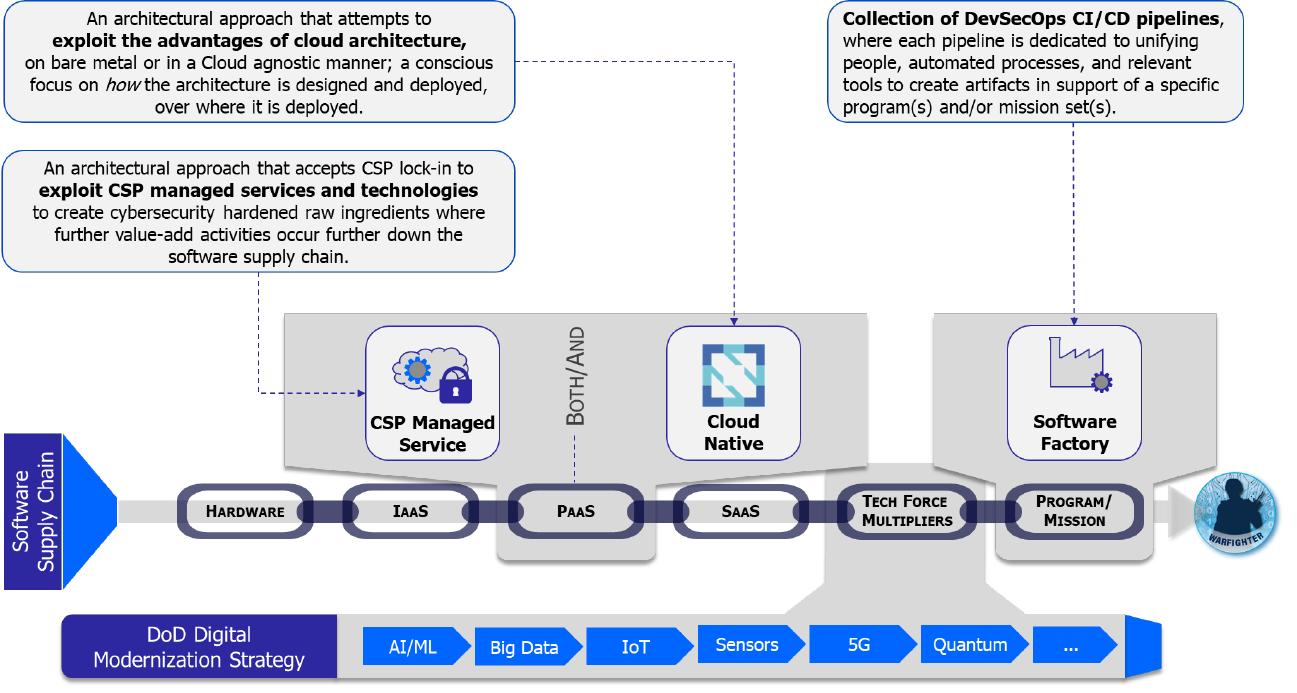
UNCLASSIFIED
4
Unclassified
Figure 1 Notional Software Supply Chain
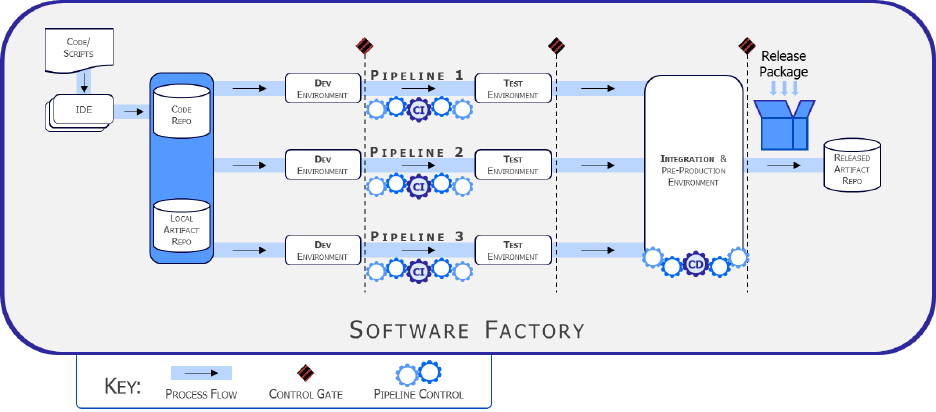
UNCLASSIFIED
5
Unclassified
Figure 2 Normative Software Factory Construct
Each factory is expected be instantiated from hardened IaC code and scripts or DoD hardened
containers from the sole DoD artifact repository, Iron Bank. In the case of a CNCF Certified
Kubernetes powered software factory, the core services must also come from DoD hardened
containers pulled from Iron Bank. Once the software factory is up and running, the developers
predominately use their integrated development environments (IDEs) to begin creating their
custom software artifacts, using the services offered by the specific software factory.
Every bit of free and open software source (FOSS), Commercial off the Shelf (COTS),
Government off the Shelf (GOTS), and/or newly developed code and supporting scripts,
configuration files, etc. are committed into the factory’s local artifact repo or code repository,
respectively. With each commit to the code repository, the assembly line automation kicks in.
There are multiple continuous integration / continuous delivery (CI/CD) pipelines executing in
parallel, representing different unique artifacts being produced within the factory.
The adoption of CI/CD pipelines reduce risk by making many small, incremental changes
instead of a “big bang” change. The incremental changes of application code, infrastructure
code, configuration code, compliance code, and security code can be reviewed quickly.
Mistakes introduced are easier to capture and isolate when few things have changed.
The development environment contains the rawest form of source code. When a developer
looks to merge their completed work into the main branch of the code repository, they encounter
a control gate. If the code is successfully compiled, it will forward with a pull/merge request for
peer review, a critical security step that is the software code equivalent of two-person integrity. If
the peer review identifies security flaws, architectural concerns, a lack of appropriate
documentation within the code itself, or other problems, it can reject the merge request and
send the code back to the software developer for rework. Once the merge request is approved,
and the merge completed, the continuous integration step is triggered.
Continuous integration executes unit tests, such as Static and Dynamic Application Security
Test (SAST), verify the integrity of the work in the broader context of the artifact or application.
UNCLASSIFIED
6
Unclassified
The CI assembly line is solely responsible at this point for guiding the subsystem, including
dependency tracking, regression tests, code standards compliance, and pulling dependencies
from the local artifact repository, as necessary. When the CI completes, the artifact is
automatically promoted to the test environment.
Usually, the test environment is where a more in-depth set of tests are executed, for example,
hardware-in-the-loop (HWIL) testing or software-in-the-loop (SWIL) testing may occur,
especially when the hardware is too expensive or too bulky to provide to each individual
developer to work against locally. In addition, the test environment performs additional or more
in-depth testing variants of static code analysis, functional tests, interface tests, and dynamic
code analysis. If all of these tests complete without error, then the artifact is poised to pass
through another control gate into the integration environment, or be sent back to the
development team to fix any issues discovered during the automated testing.
Once the code and artifact(s) reach the integration environment, the continuous deployment
(CD) assembly line is triggered. More tests and security scans are performed in this
environment, including operational and performance tests, user acceptance test, additional
security compliance scans, etc. Once all of these tests complete without issue, the CD
assembly line releases and delivers the final product package to the released artifact repository.
Released is never equivalent to Deployed! This is a source of confusion for many. A released
artifact is available for deployment. Deployment may or may not occur instantly. A laptop that is
powered off when a security patch is pushed into production will not immediately receive the
artifact. Larger updates or out-of-cycle refreshes like anti-virus definition refreshes often require
the user to initiate. The deployment occurs later. While this is a trivialized example, it effectively
illustrates that released is never equivalent to deployed.
In summary, the DevSecOps software factory provides numerous benefits, including:
• Rapid creation of hardened software development infrastructure for use by a
DevSecOps team.
• A dynamically scalable set of pipelines with three distinct cyber survivability control
gates.
• Developmental and Operational Test & Evaluation is shifted left, moved into the CI/CD
pipelines instead of bolted on the end of the process, facilitating more rapid feedback to
the development teams.
• Simplified governance through the use of pre-authorized IaC scripts for the development
environment itself
• Assurance as an Authorizing Official (AO) that functional, security, integration,
operational, and all other tests are reliably performed and passed prior to formal release
and delivery.

UNCLASSIFIED
7
Unclassified
3.2 Software Supply Chain Imperatives
Evaluation of every software supply chain must consider a series of imperatives that span
development, security, and operations – the pillars of DevSecOps. Regardless of the specific
software factory reference design that is applied, there are a core set of imperatives that must
always exist. These imperatives include:
• Use of agile frameworks and user-centered design practices.
• Baked-in security across the entirety of the software factory and throughout the software
supply chain.
• Shifting cybersecurity left.
• Shifting both development tests and operational tests left.
• Reliance on IaC and CaC to avoid environment drifts between deployments.
• Use of a clearly identifiable CI/CD pipeline(s).
• Adoption of Zero Trust principles and a Zero Trust Architecture throughout, both north-
south and east-west traffic.
5
• Comprehension and transparency of lock-in decisions, with a preference for avoiding
vendor lock-in.
• Comprehension and transparency of the cybersecurity stack, with a preference for
decoupling it from the application workload.
• Centralized log aggregation and telemetry.
• Adoption of at least the DevOps Research and Assessment (DORA) performance
metrics, defined in full in the section Measuring Success with Performance Metrics.
Additional imperatives across development, security, and operations should be considered.
3.2.1 Development Imperatives
• Favor small, incremental, and frequent updates over larger, more sporadic releases.
• Apply cross-functional skill sets of Development, Cybersecurity, and Operations
throughout the software lifecycle, embracing a continuous monitoring approach in
parallel instead of waiting to apply each skill set sequentially.
• With regard to legacy software modernization, lift & shift is a myth. Simply moving
applications to the cloud for re-hosting by lifting the code out of one environment and
shifting it to another is not a viable software modernization approach. True
modernization will require applications be rebuilt to cloud-specific architectures, and
DevSecOps will be fundamental in this journey.
• Continuously monitor environment configurations for unauthorized changes.
• Deployed components must always be replaced in their entirety, never update in place.
3.2.2 Security Imperatives
• Zero Trust principles must be adopted throughout.
• Configure control gates with explicit, transparently understood exit criteria tailored to
meet the AO’s specific risk tolerance.
5
National Institute of Standards and Technology, “NIST Special Publication 800-207, Zero Trust
Architecture.” August, 2020.

UNCLASSIFIED
8
Unclassified
• Ensure the log management and aggregation strategy meets the AO’s specific risk
tolerance.
• Support Cyber Survivability Endorsement (CSE) for the specific application and data, the
DoD Cloud Computing Security Requirements Guide (SRG), and industry best
practices.
6,7
NOTE: Teams should discuss and understand how the CSE is factored into technical
design assessments, RFP source selection, and operational risk trade space decisions
throughout the system’s lifecycle. Early consideration of cyber survivability requirements
can prevent the selection of foundationally flawed technology implementations (cost
drivers) that are frequently rushed to market without incorporating best business practice
development for cybersecurity and cyber resilience.
• Automate as much developmental and operational testing and evaluation (OT&E),
including functional tests, security tests, and non-functional tests, as possible.
• Recognize that the components of the platform can be instantiated and hardened in
multiple different ways, to include a mixture of these options:
o Using Cloud Service Provider (CSP) managed services, providing quick
implementation and deep integration with other CSP security services, but with
the “cost of exit” that these services will have different APIs and capabilities on a
different cloud, and are unavailable if the production runtime environment is not
in the cloud (e.g., an embedded system on a weapons system platform).
o Using hardened containers from a DoD authorized artifact repository, e.g. Iron
Bank, to instantiate a CSP-agnostic solution running on a CNCF-compliant
Kubernetes platform.
• Formal testing goes from testing each new environment to testing the code that
instantiates the next new environment.
• Expressly define an access control strategy for privileged accounts; even if someone is
privileged, that doesn’t mean they need the authorization to be turned on 24x7.
3.2.3 Operations Imperatives
• Continuous monitoring is necessary and contextually related to the ThreatCon; what was
a non-event last week may be a critical event this week.
• Only accept a “fail-forward” recovery. Failing forward recognizes that the time taken to
roll out a deployment and revert to a prior version is often equivalent to the amount of
time it takes for the software developer to fix the problem and push it through the
automated pipeline, thus “failing forward” to a newer release that fixes the problem that
existed in production.
• Recognize and adopt blue/green deployments when possible. A Blue/Green deployment
exists when the existing production version continues to operate alongside the newer
version being deployed, providing time for a minor subset of production traffic to be
routed over to the newer version to validate the deployment, or for the development
team to validate the deployment alongside security and operations peers. Once the
6
Department of Defense, “Cyber Survivability Endorsement Implementation Guide, v2.01,” [Online].
Available: https://intelshare.intelink.gov/sites/cybersurvivability/
. [Accessed 03 Aug, 2021].
7
DISA, “Department of Defense Cloud Computing Security Requirements Guide, v1r3,” Mar 6, 2017.

UNCLASSIFIED
9
Unclassified
newer version has been validated, 100% of the traffic can be routed to the new
deployment, and the old deployment resources can be reclaimed.
• Recognize and adopt canary deployments for new features. A canary deployment is
when a feature can be enabled or disabled via metadata and it is only enabled on a
minor percentage of the cluster such that only a few users actually see the new
capability.
8
Through continuous monitoring of usage, the DevSecOps team can evaluate
metrics and usefulness of the feature and determine if it should be made widely
available, or if the feature needs to be re-worked.
8
LaunchDarkly, “What is a Canary Deployment?,” [Online]. Available: https://launchdarkly.com/blog/what-
is-a-canary-deployment. [Accessed 03 Aug 2021].
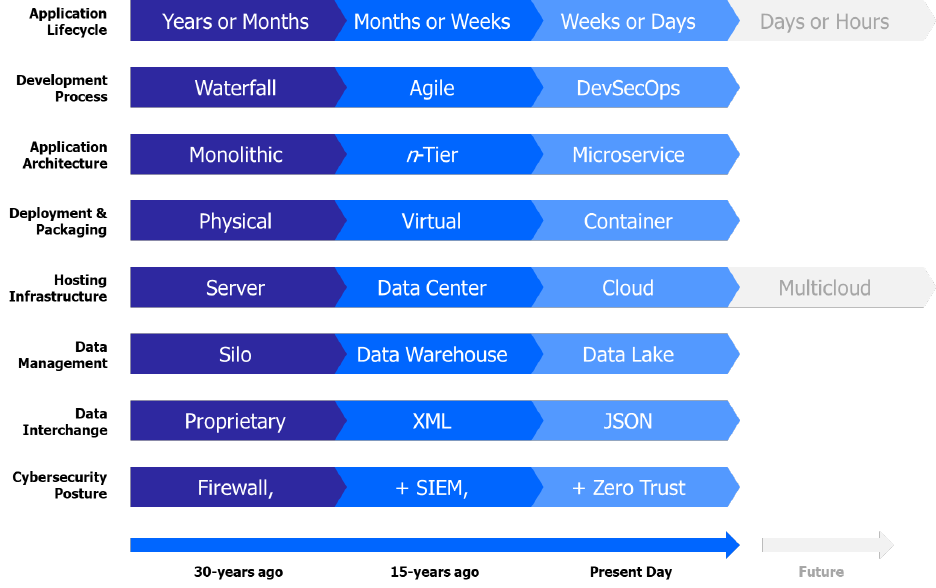
UNCLASSIFIED
10
Unclassified
4 DevSecOps
4.1 DevSecOps Overview
Software development best practices are ever-evolving as new ideas, new frameworks, new
capabilities, and radical innovations become available. Over time we witness technological
shifts that relegate what was once state-of-the-art to be described as legacy or deprecated. In
wireless, 2.5G systems have been fully retired, 3G systems were aggressively replaced by 4G
LTE with shutdown dates publicly announced, and now 4G LTE is being supplanted by the rise
of 5G. Software is no different, and Practices depicts the broad trends over the last 30 years.
Different programs and application teams may be more advanced in one aspect and lagging in
another.
Figure 3 Maturation of Software Development Best Practices
W
hile tightly coupled monolithic architectures were the norm, the growth of finely grained,
loosely coupled microservices are now considered state-of-the-art and have evolved the Service
Oriented Architecture (SOA) concept of services and modularity. Development timeframes have
compressed, deployment models have shifted to smaller containerized packaging, and the
cloud portends to deliver an endless supply of computing capacity as infrastructure for compute,
storage, and network have shifted from physical to virtual to cloud.
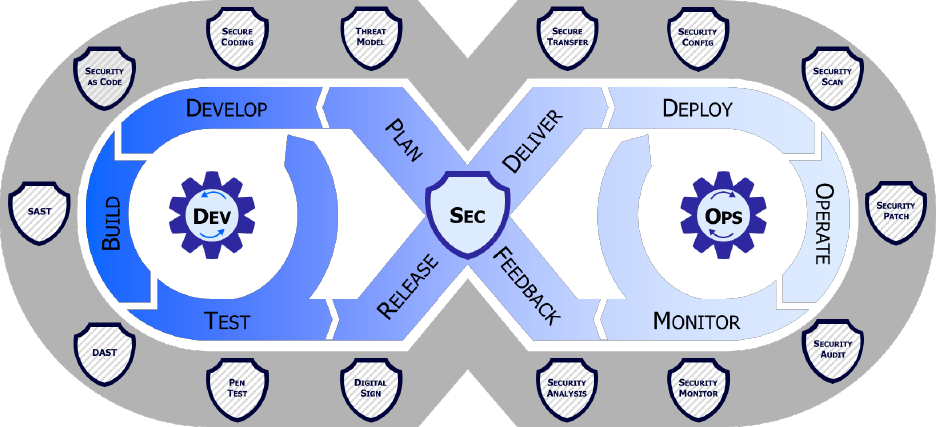
UNCLASSIFIED
11
Unclassified
The shift towards DevSecOps, microservices, containers, and Cloud necessitates a new
approach to cybersecurity. Security must be an equal partner with the development of business
and mission software capabilities, integrated throughout the phases between planning and
production.
The alluring characteristics of DevSecOps is how it improves customer and mission outcomes
through implementation of specific technologies that automate processes and aid in the delivery
of software at the speed of relevance, a primary goal of the DoD’s software modernization
efforts. DevSecOps is a culture and philosophy that must be practiced across the
organization, realized through the unification of a set of software development (Dev), security
(Sec) and operations (Ops) personnel into a singular team. The DevSecOps lifecycle phases
and philosophies, depicted in Figure 4, is an iterative closed loop lifecycle that spans eight
distinct phases. Teams new to DevSecOps are encouraged to start small and build it up their
capabilities, progressively, striving for continuous process improvement at each of the eight
lifecycle phases.
NOTE: The cybersecurity activities in the figure 4 outer rim are notional and incomplete. See the
DevSecOps Tools and Activities Guidebook for full set of REQUIRED/PREFERRED activities.
Figure 4 DevSecOps Distinct Lifecycle Phases and Philosophies
T
he Security value of DevSecOps is achieved through a fundamental change in the culture and
approach to cybersecurity and functional testing. Security is continuously shifted left and
integrated throughout the fabric of the software artifacts from day zero. This approach differs
from the stale view that operational test and evaluation (OT&E) and cybersecurity can simply be
bolt-on activities after the software is built and deployed into production. When security
problems are identified in production software, they almost always require the software
development team to (re-)write code to fix the problem. The DevSecOps differentiation is
realized fully only when security and functional capabilities are built, tested, and monitored at

UNCLASSIFIED
12
Unclassified
each step of the lifecycle, preventing the security and functional problems from reaching
production in the first place.
Each of the shields surrounding the DevSecOps lifecycle in Figure 4 represents a distinct
category of cybersecurity testing and activities. This blanket of protection is intentionally
depicted surrounding the eight distinct phases of the DevSecOps lifecycle because these tests
must permeate throughout the lifecycle to achieve benefits. Failure to weave security and
functional testing into just one of the eight phases can create a risk of exposure, or worse,
compromise, in the final production product.
Some people describe DevSecOps as emphasizing cybersecurity over compliance; this is
recognition that you can be compliant, but not secure, and you can be secure, but not
compliant. Sidestepping the debate on the fairness of this characterization of DevSecOps, the
below considers the specific characteristics espoused by DevSecOps practitioners:
• Fully automated risk characterization, monitoring, and mitigation across the application
lifecycle is paramount.
• Automation and the security control gates continuously evaluate the cybersecurity
posture while still empowering delivery of software at the speed of relevance.
• Support meeting Cyber Survivability Endorsement (CSE) Cyber Survivability Attribute
(CSA) number 10 – Actively Manage System’s Configurations to Achieve and Maintain
an Operationally Relevant Cyber Survivability Risk Posture (CSRP).
9,10
There are additional benefits to the Government where specific choices in technology
implementations and data collection can automate traditionally manual processes, such as risk
characterization, monitoring and mitigation, across the entire application lifecycle. Another pain
point felt by the Government relates to updating and patching systems, something that can be
fully automated from a DevSecOps tech stack because of its emphasis on automation and
control gates.
Strictly speaking, DevSecOps adoption does not require a specific architecture, containers,
or even explicit use of a Cloud Service Provider (CSP). However, the use of these things are
strongly recommended, and in some cases mandated by specific Reference Designs. The
goal of software modernization and what DevSecOps must drive is the ability deliver resilient
software capabilities at the speed of relevance through the release of incremental capabilities
in a decoupled fashion.
4.2 DevSecOps Culture & Philosophy
DevSecOps, and its predecessor DevOps, is a culture and philosophy. DevSecOps builds upon
the value proposition of DevOps by expanding its culture and philosophy to recognize that
maximizing cyber survivability requires integrating cybersecurity practices throughout the entire
systems development lifecycle (SDLC). DevSecOps advances the growing philosophy and
sentiment that reliance upon bolt-on or standalone monolithic cybersecurity platforms is
9
DoD, “Cybersecurity Test and Evaluation Guidebook, Version 2.0, Change 1,” Feb 10, 2020
10
Department of Defense, “Cyber Survivability Endorsement Implementation Guide, v2.01,” [Online].
Available: https://intelshare.intelink.gov/sites/cybersurvivability/
. [Accessed 03 Aug, 2021].

UNCLASSIFIED
13
Unclassified
incapable of providing adequate security in today’s operational environments. Cybersecurity
tooling that is fully isolated from the development and operational environments are reactive at
best, whereas integrated automated tooling with the software factory is proactive.
A proactive culture recognizes that it is better to detect and halt the deployment of a
cybersecurity risk within the software factory pipelines instead of detecting it after the fact in
production. Further the DevSecOps cybersecurity culture embraces another core Agile tenet
that prefers work software over comprehensive documentation. Mounds of cybersecurity
documentation do not offer an assurance that software is secure; automated tests and testing
outputs continuously executed within the software factory pipelines captures meaningful, timely
metrics that provide a higher level of assurance to AOs.
There are several key principles for a successful transition to a DevSecOps culture:
• Continuous delivery of small incremental changes.
• Bolt-on security is weaker than security baked into the fabric of the software artifact.
• Value open source software.
• Engage users early and often.
• Prefer user centered & Warfighter focus and design.
• Value automating repeated manual processes to the maximum extent possible.
• Fail fast, learn fast, but don’t fail twice for the same reason.
• Fail responsibly; fail forward.
• Treat every API as a first-class citizen.
• Good code always has documentation as close to the code as possible.
• Recognize the strategic value of data; ensure its potential is not unintentionally
compromised.
4.2.1 DevSecOps Cultural Progression
As a program’s DevSecOps culture matures, it should progress along "the three ways", as
introduced in the book The Phoenix Project, and as described in the seminal book The DevOps
Handbook:
11,12
1. First Way: Flow. “The First Way enables fast left-to-right flow of work from Development to
Operations to the customer. In order to maximize flow, we need to make work visible,
reduce our batch sizes and intervals of work, build in quality by preventing defects from
being passed to downstream work centers, and constantly optimize for the global goals. By
speeding up flow through the technology value stream, we reduce the lead time required to
fulfill internal or customer requests, especially the time required to deploy code into the
production environment. By doing this, we increase the quality of work as well as our
throughput, and boost our ability to out-experiment the competition. The resulting practices
include continuous build, integration, test, and deployment processes; creating
environments on demand; limiting work in process (WIP); and building systems and
organizations that are safe to change.” - [The DevOps Handbook].
11
G. Kim, K. Behr, and G. Spafford, The Phoenix Project: A Novel about IT, DevOps, and Helping Your
Business Win, IT Revolution Press, 2013
12
G. Kim, J. Humble, P. Debois, and J. Willis, The DevOps Handbook: How to Create World-Class Agility,
Reliability, and Security in Technology Organizations, IT Revolution Press, 2016

UNCLASSIFIED
14
Unclassified
2. Second Way: Feedback. “The Second Way enables the fast and constant flow of feedback
from right to left at all stages of our value stream. It requires that we amplify feedback to
prevent problems from happening again, or enable faster detection and recovery. By doing
this, we create quality at the source and generate or embed knowledge where it is needed—
this allows us to create ever-safer systems of work where problems are found and fixed long
before a catastrophic failure occurs. By seeing problems as they occur and swarming them
until effective countermeasures are in place, we continually shorten and amplify our
feedback loops, a core tenet of virtually all modern process improvement methodologies.
This maximizes the opportunities for our organization to learn and improve.” - [The DevOps
Handbook].
3. Third Way: Continual Learning and Experimentation. “The Third Way enables the creation of
a generative, high-trust culture that supports a dynamic, disciplined, and scientific approach
to experimentation and risk-taking, facilitating the creation of organizational learning, both
from our successes and failures. Furthermore, by continually shortening and amplifying our
feedback loops, we create ever-safer systems of work and are better able to take risks and
perform experiments that help us learn faster than our competition and win in the
marketplace.” - [The DevOps Handbook].
4.3 Zero Trust in DevSecOps
The DevSecOps ecosystem that includes the software factory and the intrinsic blending across
development, security, and operational creates complexity. This complexity has outstripped
legacy security methods predicated upon “bolt-on” cybersecurity tooling and perimeter
defenses. Zero Trust must be the target security model for cybersecurity adopted by
DevSecOps platforms and the teams that use those platforms.
There is no such as a singular product that delivers a zero trust architecture because zero trust
focuses on service protection, and data, and may be expended to include the complete set of
enterprise assets.
5
This means zero trust touches infrastructure components, virtual and cloud
environments, mobile devices, servers, end users, and literally every part of an information
technology ecosystem. To encompass all of these things, zero trust defines a series of
principles that when thoughtfully implemented and practiced with discipline prevent data
breaches and limit the internal lateral movement of a would-be attacker.
DevSecOps teams must consistently strive to bake in zero trust principles across each of the
eight phases of the DevSecOps SDLC, covered in the next section. Further, DevSecOps teams
must fully consider security from both the end user perspective and all non-person entities
(NPEs). To illustrate several of these concept in a notional list, these NPEs include servers, the
mutual transport layer security (mTLS) between well-defined services relying on FIPS compliant
cryptography, adoption of deny by default postures, and understanding how all traffic, both
north-south and east-west, is protected throughout the system’s architecture.
4.4 Behavior Monitoring in DevSecOps
The software factory platform and the DevSecOps team will quickly establish a normative set of
behaviors. To illustrate this point, a merge into the main branch should never occur without a
pull request that includes two or more additional engineers reviewing the code for quality,
purpose, and cybersecurity. There are two types of behavior monitoring that are required to
support the ideals of Zero Trust, covered above, and to enhance the overall cyber survivability
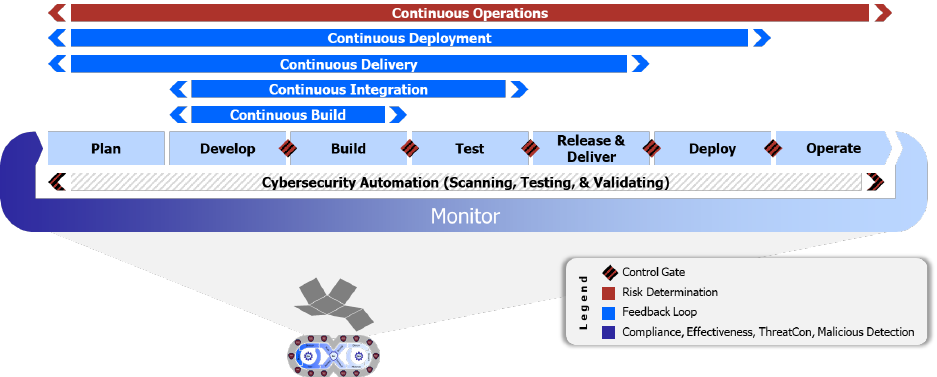
UNCLASSIFIED
15
Unclassified
of the software factory platform, the software artifacts being produced within that factory, and
the different environments linked to the software factory: Behavior Detection and Behavior
Prevention. The idea of detection is to trigger an actionable and logged alert, possibly delivered
through a ChatOps channel to the entire team that conveys I saw something anomalous. The
idea of prevention goes a step further. It still triggers an actionable and logged alert, but it also
either proactively prevents or immediately terminates anomalous behaviors and conveys I
inhibited something anomalous. There are a multitude of technologies available to achieve
behavior monitoring in a DevSecOps environment. At a minimum, teams must incorporate
behavior detection, and they should aspire and drive to incorporate behavior prevention
throughout the software factory and its environments.
5 DevSecOps Lifecycle
The DevSecOps software lifecycle is most often represented using a layout that depicts an
infinity symbol, depicted previously in Figure 4. This representation emphasizes that the
software development lifecycle is not a monolithic linear process. There are eight phases: plan,
develop, build, test, release, deliver, deploy, operate, and monitor, each complimented by
specific cybersecurity activities.
DevSecOps is iterative by design, recognizing that software is never done. The “big bang”
style delivery of the Waterfall process is replaced with small, frequent deliveries that make it
easier to change course as necessary. Each small delivery is accomplished through a fully
automated process or semi-automated process with minimal human intervention to accelerate
continuous integration and continuous delivery. This lifecycle is adaptable and as discussed
next, includes numerous feedback loops that drive continuous process improvements.
NOTE: The unfolded “infinity” DevSecOps diagram depicted in Figure 5 is used to better
illustrate the relationship between the lifecycle phases and the continuous feedback loops used
to drive continuous process improvement.
Figure 5 "Unfolded" DevSecOps Lifecycle Phases
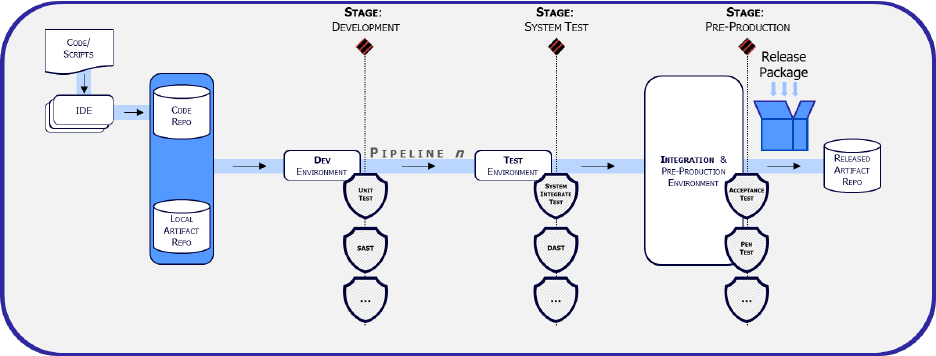
UNCLASSIFIED
16
Unclassified
5.1 Cybersecurity Testing at Each Phase
There is no “one size fits all” solution for cybersecurity testing design. Each software team has
its own unique requirements and constraints. However, the software artifact promotion
control gates are a mandatory part of the software factory; their inclusion cannot be
waivered away. Figure 6 depicts where each of the mandatory control gates are within each of
the software factory’s pipelines, depicted by the diamonds at the top of the graphic. The graphic
depicts a notional and incomplete sampling of the types of tests at each gate; different pipelines
within the software factory may define different collections of tests to maximize the effectiveness
of a control gate.
Figure 6 Notional expansion of a DevSecOps software factory with illustrative list of tests
T
he control gates are mandatory, but there is no expectation that they are fully automated from
the moment the software factory is instantiated. On the contrary, because each program’s
requirements are unique, and as espoused by agile practices, it is expected that initially control
gates may require human intervention. As the team matures through continuous process
improvement, the team should identify repeatable actions and add automation of those actions
into the team’s backlog. The complete team must have strong confidence in the automation built
at a control gate. To recap, as a best practice, start with more human intervention and gradually
decrease human intervention in favor of repeatable automation as part of a continuous process
improvement process.
One final note about the control gates; while they are described predominately as being cyber
focused and preventing environmental and behavioral drift, it is vital to incorporate meaningful
developmental test and evaluation (DT&E) and operational test & evaluation (OT&E)
assessments when and where possible within the software factory pipelines. Shifting OT&E left
into the software factory control gates is intended to accomplish the goals depicted in Figure 7.
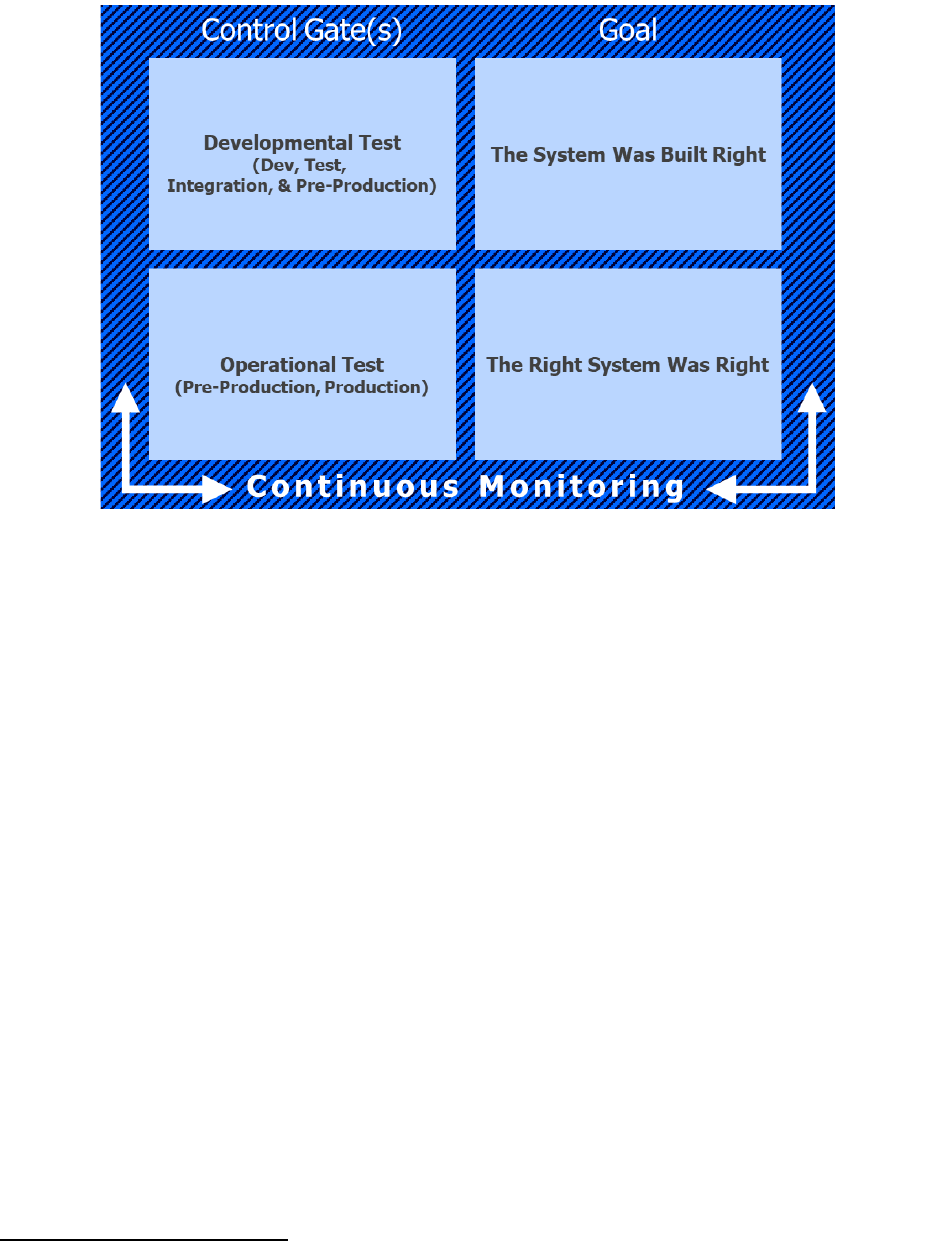
UNCLASSIFIED
17
Unclassified
Figure 7 Control Gate Goals
5.2 Importance of the DevSecOps Sprint Plan Phase
The sprint plan involves activities that help the team manage time, cost, quality, risk and issues
within the DevSecOps cycle. These activities may include business-need assessment, sprint
plan creation, and may further include at the story or epic level any combination of feasibility
analysis, risk analysis, requirements updating, business process creation, system design,
software factory modification, and ecosystem expansion.
The plan phase repeats ahead of each sprint iteration.
It is a best practice, and defined in DoDI 5000.87, “Software Acquisition Pathway,” that the
program manager (PM) and sponsor will define a minimum viable product (MVP) using iterative,
human-centered design processes. The PM and the sponsor will also define a minimum viable
capability release (MVCR) if the MVP does not have sufficient capability or performance to
deploy into operations. Use the continuous feedback loops, covered in the next section
thoroughly, to implement continuous process improvement. The adoption of continuous
feedback loops is a critical principle formalized as a Build-Measure-Learn feedback loop in the
Lean Startup methodology, and this principle is visualized by the DevSecOps infinity diagram.
13
The software factory encapsulates the DevSecOps processes, guardrails and control gates,
guiding the automation throughout the lifecycle as the team commits code. Rely upon the
DevSecOps ecosystem tools to facilitate process automation and consistent process execution,
13
E. Reis, “The Lean Startup,” [Online]. Available: http://theleanstartup.com/principles. [Accessed 04 Feb
2021].
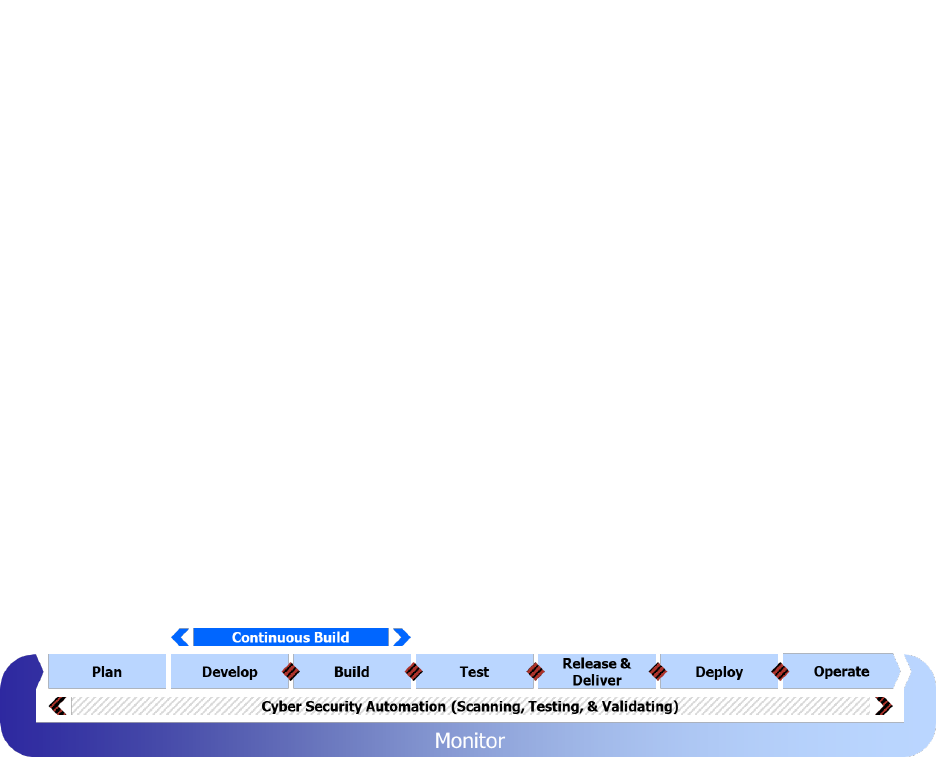
UNCLASSIFIED
18
Unclassified
recognizing the value in a continuous process improvement approach instead of a “big bang”
approach.
The entirety of the DevSecOps team must have access to a set of communication,
collaboration, project management, and change management tools. They may or may not be
embedded within the software factory itself; in some cases, these tools may be procured as
enterprise services. There is an explicit recognition that full automation within the plan phase is
unrealistic, as the end users will collaborate with the team to establish a prioritized backlog. In
other words, the backlog work cannot be automated. Teams must recognize the value of the
planning tools in driving team interaction and collaboration, ideally increasing the team’s overall
productivity during the plan phase.
5.3 Clear and Identifiable Continuous Feedback Loops
The phases of the DevSecOps lifecycle rely upon six different continuous feedback loops. As
originally presented and visualized in Figure 5 "Unfolded" DevSecOps Lifecycle Phases, there
are three control gates that exist within the CI/CD pipeline and two additional control gates.
5.3.1 Continuous Build
The Continuous Build feedback loop iterates between the Develop and Build phases of the
DevSecOps lifecycle, depicted in Figure 8. If build doesn’t complete successfully, then the
commit must be sent back to the submitting engineer to fix; without a successful build, further
steps are both illogical and impossible to complete, thus the importance of this feedback loop.
Figure 8 Continuous Build Feedback Loop
Common types of feedback in this loop include a successful build by the build tool (because a
broken build shouldn’t be merged into the main branch) and a pull request that creates the
software equivalency of two-person integrity. The pull request performed in this feedback loop is
intended to evaluate the architecture and software structure, identify technical debt that the
original engineer may (inadvertently) introduce if this commit is merged into the main branch,
and most importantly, identify any glaring security risks and confusing code.
5.3.2 Continuous Integration
The Continuous Integration (CI) feedback loop iterates across the Develop, Build, and Test
phases of the DevSecOps lifecycle, depicted in Figure 9. Once the Continuous Build feedback
loop completes and the pull request is merged into the main branch, a complete series of
automated tests are executed, including a full set of integration tests.
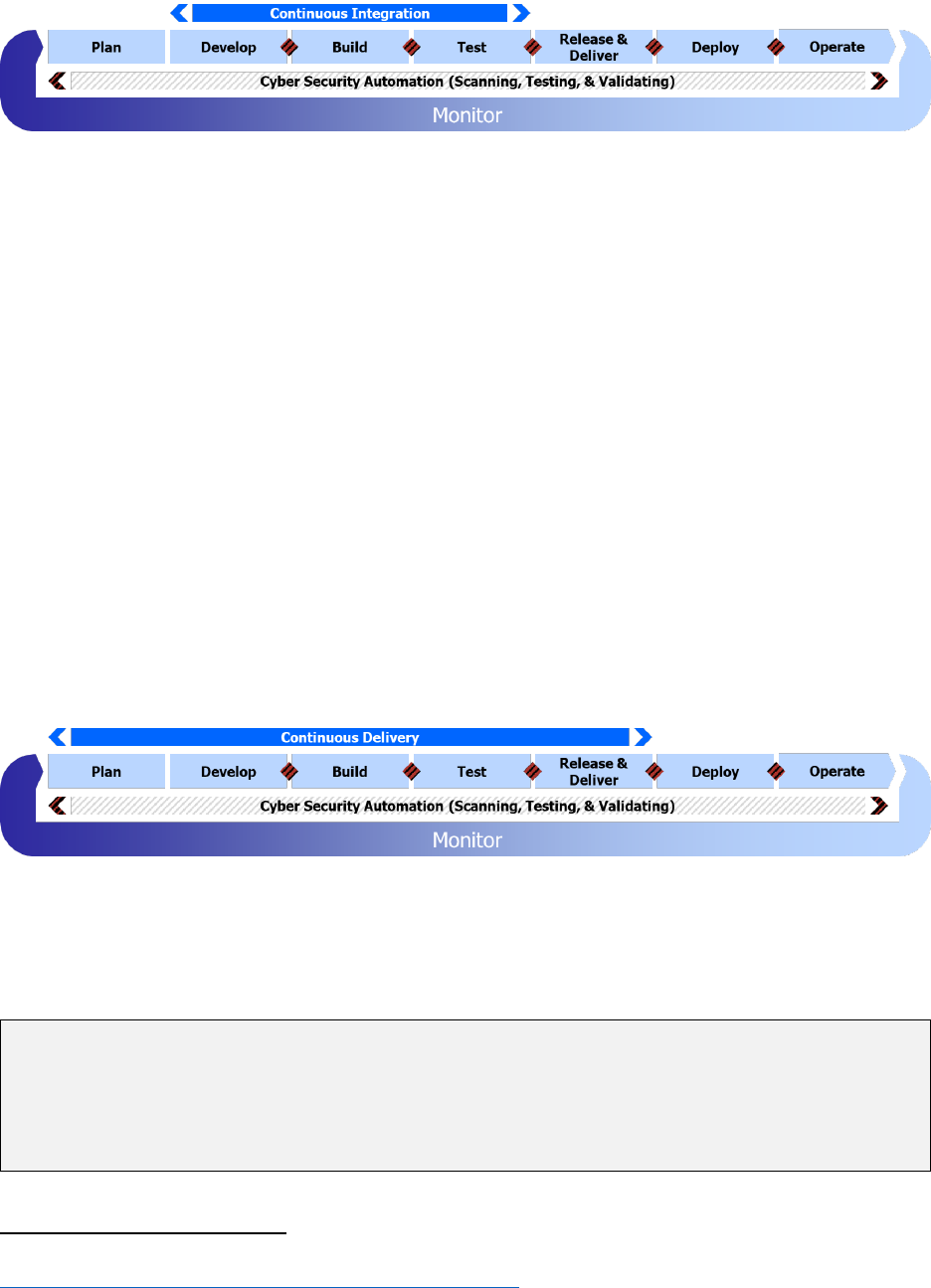
UNCLASSIFIED
19
Unclassified
Figure 9 Continuous Integration Feedback Loop
According to Martin Fowler, CI practices occur when members of a team integrate their work
frequently, usually each person integrates minimally daily, leading to multiple integrations per
day verified by an automated build (including test) to detect integration errors as quickly as
possible.
14
If multiple teams (with possibly different contractors) are working on a larger, unified
system, this means that the whole system is integrated frequently, ideally at least daily, avoiding
long integration efforts after most development is complete.
Execution of the automated test suite enhances software quality because it quickly identifies
if/when a specific merge into the main branch fails to produce the excepted outcome, creates a
regression, breaks an API, etc.
5.3.3 Continuous Delivery
The Continuous Delivery feedback loop iterates across the Plan, Develop, Build, Test, and
Release & Deliver phases of the DevSecOps lifecycle, depicted in Figure 10. The most pertinent
thing to understand is that release and delivery does not mean pushed into production.
Continuous delivery acknowledges that a feature meets the Agile definition of “Done-done.” The
code has been written, peer reviewed, merged into the main branch, successfully passed its
complete set of automated tests, and finally tagged with a version within the source code
configuration management tool and deployed into an artifact repository.
Figure 10 Continuous Delivery Feedback Loop
At this point, the feature and its related artifacts could be deployed but deployment is not
mandatory. It is common to group together a series of features and deploy them into production
as a unit, for example.
The CD acronym is often ambiguously used to mean either Continuous Delivery or
Continuous Deployment, covered next. These are related but different concepts. This
document will use CD to mean continuous delivery. In this document, CD is a software
development practice that allows frequent releases of value to staging or various test
environments once verified by automated testing. Continuous Delivery relies on a manual
decision to deploy to production, though the deployment process itself should be automated.
14
M. Fowler, “Continuous Integration.” May 01, 2006, [Online]. Available:
https://martinfowler.com/articles/continuousIntegration.html
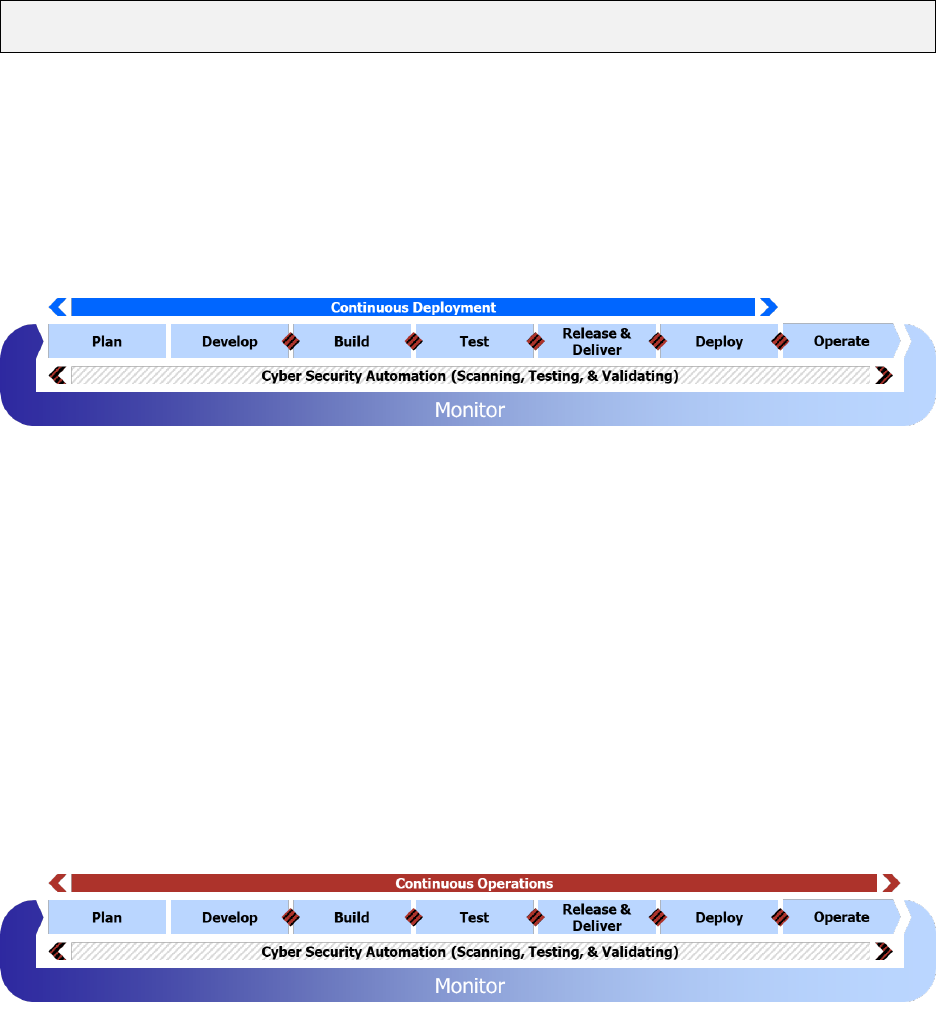
UNCLASSIFIED
20
Unclassified
In contrast, continuous deployment is the automated process of deploying changes directly
into production by verifying intended features and validations through automated testing.
5.3.4 Continuous Deployment
The Continuous Deployment feedback loop iterates across the Plan, Develop, Build, Test,
Release & Deliver, and Deploy phases of the DevSecOps lifecycle, depicted in Figure 11.
Deployment is formally the act of pushing one or more features into production in an automated
fashion. This is the first additional control gate outside of the control gates depicted in the
software factory’s CI/CD pipeline, visualized in Figure 6.
Figure 11 Continuous Deployment Feedback Loop
The use of the word continuous here is contextual and situational. First, in some programs,
continuous deployment may occur automatically when a new feature is released and delivered.
For example, during a Cloud based microservice continuous deployment, it is possible to
automate the deployment. Alternatively, if this artifact is destined for an underwater resource, it
may be several orders of magnitude harder to automatically push a 750MB release of software
to a submersed vehicle operating at 300 feet below the surface of the ocean. This scenario
further illustrates the separation between continuous delivery and continuous deployment.
5.3.5 Continuous Operations
The Continuous Operations feedback loop iterates across the Plan, Develop, Build, Test,
Release & Deliver, Deploy, and Operate phases of the DevSecOps lifecycle, depicted in Figure
12. Continuous operations are any activities focused on availability, performance, and software
operational risk.
Figure 12 Continuous Operations Feedback Loop
Availability is often illustrated best by the concept of a Service Level Agreement (SLA). Today’s
modern applications are expected to be always available with near-zero downtime, measured in
9’s. Software available 99.9% of the time can only be offline about 44 minutes per month;
99.99% availability drops to only 4 minutes per month, and so on.
This does not imply that the software is never updated. Modern microservice software
architectures built on containers offer operational characteristics that enable high availability and
performance scaling.
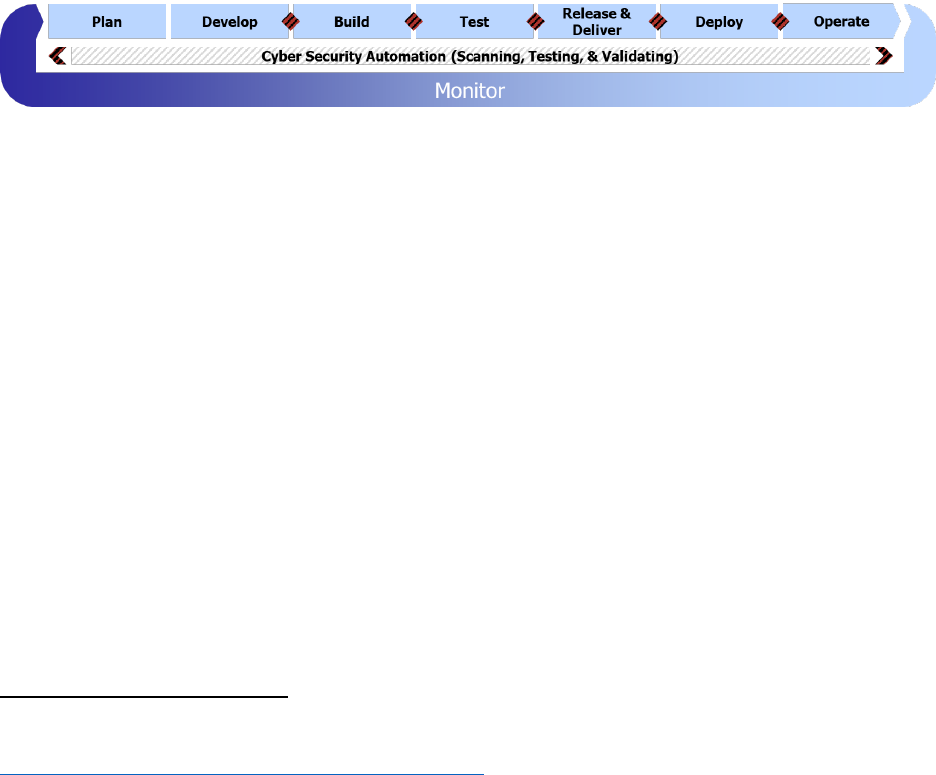
UNCLASSIFIED
21
Unclassified
Performance of the software must respond to the normal ebb and flow of user demand. The
most extreme example given is often in the retail world, where the demands during the last
month of the year, e.g., the holiday season, create massive spikes in user demand as sales are
announced. The instantaneous nature of these spikes requires heavy automation to ensure the
software performance isn’t degraded beyond usability limits.
5.3.6 Continuous Monitoring
“Information security continuous monitoring (ISCM) is defined as maintaining ongoing
awareness of information security, vulnerabilities, and threats to support
organizational risk management decisions.” – Information Security Continuous
Monitoring (ISCM) for Federal Information Systems and Organizations (NIST SP 800-
137).
15
The final, all-inclusive phase and continuous feedback loop covering all phases of the
DevSecOps lifecycle is Continuous Monitoring, depicted in Figure 13. Continuous monitoring
recognizes the totality of the system must be monitored as a whole, not only as individual parts.
This approach ensures that teams are not forming inaccurate opinions about the software by
only looking at a local minima or maxima. All aggregated metrics are monitored, from the flow of
features from backlog into production, to the outputs of each of the control gates.
Figure 13 Continuous Monitoring Phase and Feedback Loop
Continuous monitoring constantly watches all system components, watches the performance
and security of all supporting components, analyzes all system logging events, and considers all
external threat conditions that may rapidly evolve. Continuous Monitoring provides insight into
security control compliance, control effectiveness at mitigating a changing threat environment,
and resulting analysis of the residual risk compared to the authorizing officials risk tolerance.
Specific, Measurable, Attainable, Relevant, and Time-Bound (SMART) performance metrics are
also closely watched in this feedback loop. Performance metrics collected at every phase of the
DevSecOps software lifecycle must be SMART. For example, measuring how long it takes to
type a user story is specific, measurable, attainable and time-bound – but is it relevant? (The
answer is no.) The section Measuring Success with Metrics later in this document explores a
number of industry recognized SMART performance metrics that programs should adopt.
6 DevSecOps Platform
A DevSecOps Platform is defined as a multi-tenet environment that brings together a significant
portion of a software supply chain, operating under cATO or a provisional ATO. The
components of a DevSecOps platform can be instantiated in many ways, and each will include a
mixture of options. Each reference design’s unique platform configurations must be clearly
15
National Institute of Standards and Technology, “Information Security Continuous Monitoring (ISCM) for
Federal Information Systems and Organizations (SP 800-137).” Sep. 2011, [Online]. Available:
https://csrc.nist.gov/publications/detail/sp/800-137/final

UNCLASSIFIED
22
Unclassified
defined across each of these three distinct layers: Infrastructure, Platform/Software Factory,
Applications. These layers and their constituent components are depicted below in Figure 14.
The Infrastructure Layer supplies the hosting environment for the Platform/Software Factory
layer, explicitly providing compute, storage, network resources, and additional CSP managed
services to enable function, cybersecurity, and non-functional capabilities. Typically, this is
either an approved or DoD provisionally authorized environment provided by a Cloud Service
Provider (CSP), but is not limited to a CSP.
Each reference design is expected to identify its unique set of tools and activities that exist
within and/or at the boundaries between the discrete layers. These unique tool sets or
configurations that connect various aspects of the platform together are known as Reference
Design Interconnects. The purpose of the interconnect metaphor is to recognize that specific
reference design manifestations may stipulate unique environmental requirements. Well-defined
interconnects in a reference design enable tailoring of the software factory design, while
ensuring that core capabilities of the software factory remain intact. Interconnects are also the
mechanism that should be used to identify proprietary tooling or specific architectural constructs
that enhance the overall security of the reference design.
The value proposition of each Reference Design Interconnect block depicted in Figure 14 is
found in how each reference design explicitly defines specific tooling and explicitly stipulates
additional controls within or between the layers. These interconnects are an
acknowledgement of the need for platform architectural designs to support the primacy of
security, stability, and quality. Each Reference Design must acknowledge and/or define its
own set of unique interconnects.
The Platform/Software Factory Layer includes the distinct development environments of the
software factory, its CI/CD pipelines, a clearly implemented log aggregation and analysis
strategy, and continuous monitoring operations. In between each of the architectural constructs
within this layer is a Reference Design Interconnect. This layer should support multi-tenancy,
enforce separation of duties for privileged users, and be considered part of the cyber
survivability supply chain of the final software artifacts produced.
The set of environments within this layer heavily rely upon the CI/CD pipelines, each equipped
with a purpose-driven set of tools and process workflows. The environmental boundaries heavily
automated, strict control gates control promotion of software artifacts from dev to test, and from
test to integration. This layer also encompasses planning and backlog functionality,
Configuration Management (CM) repositories, and local and released artifact repositories.
Access control for privileged users is expected to follow an environment-wide least privilege
access model. Continuous monitoring assesses the state of compliance for all resources and
services evaluated against NIST SP 800-53 controls, and it must include log analysis and
netflow analysis for event and incident detection.
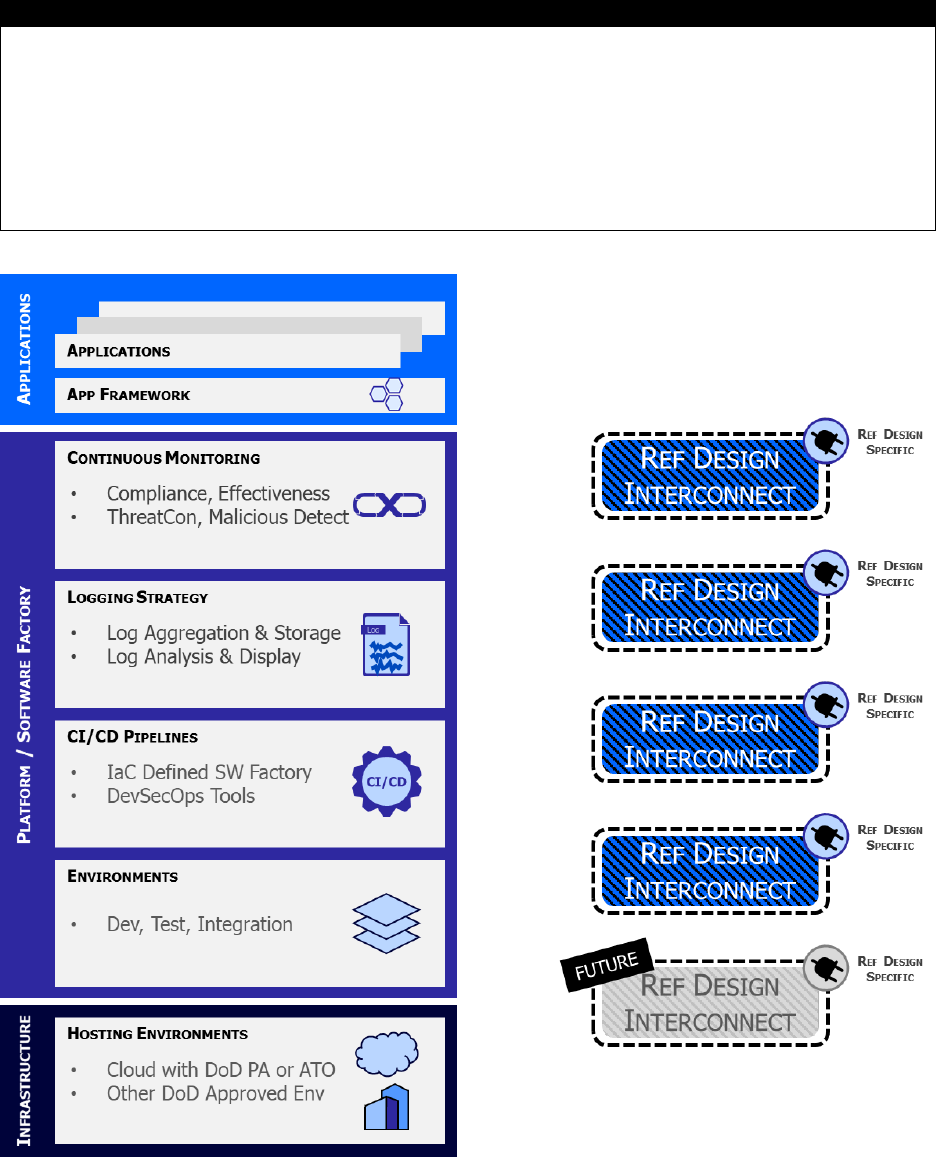
UNCLASSIFIED
23
Unclassified
Why ‘Interconnect’
Terminology can be challenging. An interconnect should be viewed as a block or unit that can
be added, updated, replaced, swapped out, etc. There was a discussion around using the
term ‘plug-in’ but the idea that something like Kubernetes could be described as a ‘plug-in’
seemed woefully inaccurate. Describing that Cloud Native Access Point (CNAP) as a ‘plug-in’
felt even more inaccurate, since CNAP is an enterprise architecture pattern. Using ‘pattern’
implied a level of abstraction, when the intention here was to define concrete requirements
within a reference design. Interconnect, something that connects two things together, seemed
like the most reasonable compromise. Thus the Reference Design Interconnect came to be!
Figure 14 Notional DevSecOps Platform with Interconnects for Unique Tools and Activities
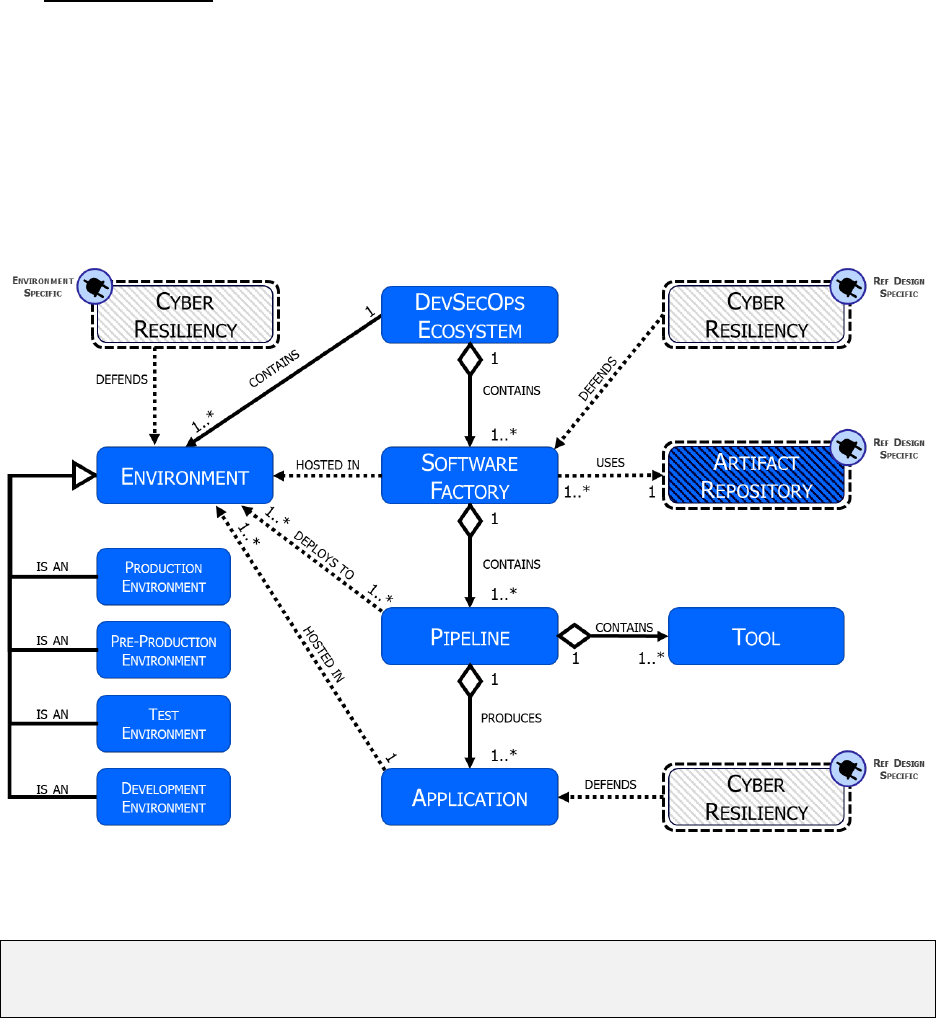
UNCLASSIFIED
24
Unclassified
The Application Layer includes application frameworks, data stores such as relational or NoSQL
databases and object stores, and other middleware unique to the application and outside the
realm of the CI/CD pipeline.
6.1 DevSecOps Platform Conceptual Model
Each DevSecOps platform is composed of multiple software factories, multiple environments,
multiple tools, and numerous cyber resiliency tools and techniques. The conceptual model in
Figure 15 visualizes the relationships between these and their expected cardinalities.
Figure 15 DevSecOps Conceptual Model with Cardinalities Defined
NOTE: When reading text along an arrow, follow the direction of the arrow. For example, a
DevSecOps Ecosystem contains one or more software factories; each software factory
contains one or more pipelines, etc.

UNCLASSIFIED
25
Unclassified
7 Current and Envisioned DevSecOps Software Factory
Reference Designs
As of the Version 2.1 update, there are now multiple DevSecOps Reference Designs at various
approval stages included in the document set. The Reference Design construct in this document
set creates the opportunity for exploration and potential approval or provisional ATO of new
types of reference designs, recognizing that industry continues to push DevSecOps culture and
philosophies into new environments. Please refer to the DevSecOps Reference Design
Pathway document, part of this document set, for insight into how a new reference design can
be introduced by the community and transition to an approved reference design.
7.1 CNCF Kubernetes Architectures
The CNCF Certified Kubernetes Reference Design is predicated upon the use of a CNCF-
compliant Kubernetes to orchestrate a collection of containers and its cybersecurity stack. The
security stack provides Zero Trust continuous monitoring with behavior detection leveraging the
reference design’s mandated Sidecar Container Security Stack (SCSS). To review the complete
reference design, please refer to the DoD Enterprise DevSecOps Reference Design: CNCF
Kubernetes.
NOTE: This remains the most mature reference design available for DoD.
7.2 CSP Managed Service Provider Architectures
The CSP ecosystem is also advancing rapidly, as CSPs look to differentiate themselves in the
market by offering complete turn-key DevSecOps environments. A managed service is an
offering where the CSP is responsible for patching and securing the core aspects of the offering,
e.g. the control plane of a managed Kubernetes service. The number of overall CSP managed
services available grows each month, and many now offer full-featured IDEs through
configuration management repositories, build tools, artifact tagging and release management,
and continuous monitoring tooling spanning an entire Cloud-based CI/CD pipeline.
The DoD Cloud IaC baselines are a service that leverage IaC automation to generate
preconfigured, preauthorized, Platform as a Service (PaaS) focused environments. These
baselines exist in the form of IaC templates that organizations can deploy to establish their own
decentralized cloud platform. These baselines significantly reduce mission owner security
responsibilities by leveraging security control inheritance from CSP PaaS managed services,
where host and middleware security is the responsibility of the CSP including hardening and
patching (no secure technical implementation guide (STIG), no host-based security system
(HBSS), and no assured compliance assessment solution (ACAS) required). Each DoD IaC
baseline includes its associated inheritable controls in eMASS to expedite the Assessment and
Authorization (A&A) process. Whenever possible, DoD Cloud IaC leverages managed security
services offered by CSP over traditional data center tools for improved integration with cloud
services. DoD Cloud IaC baselines can be built into DevSecOps pipelines to rapidly deploy the
entire environment and mission applications. The department is presently working to determine

UNCLASSIFIED
26
Unclassified
what demand signals exist for a reference design for this style of architecture.
Lock-In: As noted in the DevSecOps Strategy Guide, the government must acknowledge a
lock-in posture, recognizing vendor lock-in, and recognizing other types of lock-in like product,
platform, and mental. Today’s CSP offerings include many services, including CNCF Certified
Kubernetes. Selection of a CSP managed service architecture creates lock-in, as does
standardization on a CNCF Certified Kubernetes. What is important is to acknowledge and
understand the lock-in posture of any given architecture.
The v2.1 update of the DevSecOps document set introduces two new draft reference design for
community review: AWS CSP Managed Services and Multi-Cluster Kubernetes.
7.3 Low Code/No Code and RPA Architectures
The DevSecOps Strategy Guide explicitly defines the need to scale to any type of operational
requirement needing software, to include business systems, attended and unattended bots, and
beyond. There are rapid advancements taking place in low code/no code and robotic process
automation (RPA) tooling and architectures. In this release (v2), there is neither an approved
nor a provisionally authorized DevSecOps reference design for this type of environment.
However, there has been a growing amount of discussion about how to leverage the cultural
and philosophical ideals of DevSecOps in this area.
7.4 Serverless Architectures
Serverless architectures rely on fully managed and scalable hardware in a way that allows the
software developer to emphasis business process over architecture. Serverless has rapidly
matured, with commercial offerings across all major CSPs and open source libraries that plug-in
to existing ecosystems like CNCF Certified Kubernetes stacks. In this release (v2), there is
neither an approved nor a provisionally authorized standalone DevSecOps reference design for
this type of environment.
Of note, Kubernetes supports Serverless workloads and Serverless architectures within the
DoD Enterprise DevSecOps Reference Design: CNCF Kubernetes.
8 Deployment Types
Continuous Deployment is triggered by the successful delivery of released artifacts to the
artifact repository, and deployment may be subject to control with human intervention according
to the nature of the application.
The following four deployment activities are intrinsically supported by K8s, so there are no new
tool requirements beyond the use of Kubernetes captured earlier in this document.
8.1 Blue/Green Deployments
K8s offers exceptional support for what is known as Blue/Green Deployments. This style of
deployment creates two identical environments, one that retains the current production
container instances and the other that holds the newly deployed container instances. Both
environments are fronted by either a router or a load balancer that can be configured to direct
UNCLASSIFIED
27
Unclassified
traffic to a specific environment based on a set of metadata rules. Initially, only the blue
environment is getting production traffic. The green version can run through a series of post-
deployment tests, some automated and some human driven. Once the new version is deemed
to be stable and its functionality is working properly, the router or load balancer is flipped,
sending all production traffic to the green environment. If an unanticipated issue occurs in the
green environment, traffic can be instantaneously routed back to the stable blue environment.
Once there is a high degree of confidence in the green environment, the blue environment can
be automatically torn down, reclaiming those compute resources.
8.2 Canary Deployments
K8s also offers exceptional support for Canary deployments. This style of deployment pushes a
new feature of capability into production and only makes it accessible to a small group of people
for testing and evaluation. In some cases, these small groups may be actual users, or they may
be developers. Typically, the percentage of users given access to the feature or capability will
increase overtime. The goal is to verify that the application is working correctly with the new
feature or capability installed in the production environment. The route to the feature is most
often controlled through a route that is configured in such a way that only a small percent of the
incoming traffic is forwarded to the newer (canary) version of the containerized application,
perhaps based on a user's attributes.
8.3 Rolling Deployments
A rolling deployment occurs when a cluster slowly replaces its currently running instances of an
application with newer ones. If the declarative configuration of the application calls for n
instances of the application deployed across the K8s cluster, then at any point in time the
cluster actually has (n + 1) instances running. Once the new instance has been instantiated and
verified through its built-in health checks, the old instance is removed from the cluster and its
compute resources recycled.
The major benefit of this approach is the incremental roll-out and gradual verification of the
application with increasing traffic. It also requires less compute resources than a Blue/Green
deployment, requiring only one additional instance instead of an entire duplication of the cluster.
A disadvantage of this approach is that the team may struggle with an (n-1) compatibility
problem, a major consequence for all continuous deployment approaches. Lost transactions
and logged-off users are also something to take into consideration while performing this
approach.
8.4 Continuous Deployments
This style of deployment is tightly integrated with an array of DevSecOps tools, including the
artifact repository for retrieving new releases, the log storage and retrieval service for logging of
deployment events, and the issue tracking system for recording any deployment issues. The
first-time deployment may involve infrastructure provisioning using infrastructure as code (IaC),
dependency system configuration (such as monitoring tools, logging tools, scanning tools,
backup tools, etc.), and external system connectivity such as DoD common security services.
Continuous deployment differs from continuous delivery. In continuous delivery, the artifact is
deemed production ready and pushed into the artifact repository where it could be deployed into
production at a later point in time. Continuous deployment monitors these events and

UNCLASSIFIED
28
Unclassified
automatically begins a deployment process into production. Continuous deployment often works
well with a rolling deployment strategy.
9 Minimal DevSecOps Tools Map
The following material is a high-level summary of the DevSecOps Tools and Activities
Guidebook included with this document set. The Guidebook provides a clean set of tables that
completely captures both required and preferred tooling across each lifecycle phase’s activities.
Each Reference Design is expected to augment the DevSecOps Tools and Activities
Guidebook, adding in its environmentally specific required and preferred tooling. Reference
Designs cannot remove a required tool or activity, only augment.
9.1 Architecture Agnostic Minimal Common Tooling
Every DevSecOps software factory must include a minimal set of common tooling. The use of
the word common is indicative of a class of tooling; it does not nor should it be construed that
the same tool must be used across every reference design. The following is a list of the
common tools that are expected to be available within a DevSecOps software factory:
• Team Collaboration System: A popular example is Atlassian Confluence, a
collaborative wiki that allows teams to share documentation in a way that is deeply
integrated into the issue tracking system. The selected tool must support multi-tenancy.
• Issue Tracking System: A popular example is Atlassian Jira, a robust issue tracking
system that is customizable to meet the needs of each specific team. The selected tool
must support multi-tenancy.
• Integrated Development Environment: Many different IDEs exist, a popular example
tuned for building and debugging modern cloud applications is Visual Studio Code.
• Source Code Repository: All DevSecOps software factories must use a git based
repository. Popular git based repositories include GitLab and Atlassian Bitbucket.
• Build Tool: The build tool is an essential part of the CI/CD pipeline. A popular example
of a build tools is Jenkins.
• Artifact Repository: The artifact repository must integrate into the build tool, providing
access to both dependency artifacts required to complete the build, as well as storing
artifacts that a result of the build.
• Automated Test Development Tooling / Suite: The specific features of the testing
suite will be explicitly linked to the type of application be designed and built.
• Test Coverage Reporting Tool: Teams are encouraged to establish a high (but
reasonable) threshold for code test coverage and reporting of coverage level is vital.
• Static and Dynamic Application Security Test (SAST, and DAST, respectively)
Tools: Advanced tools can detect a range of concerns, spanning poorly implemented
software algorithms to glaring (and not so glaring) security holes.
• Log Strategy: Log aggregation, analysis, and auditing tools must be incorporated into
the operation of every software factory.
• Continuous Monitoring: InfoSec and operational monitoring of the entire software
factory is mandatory, and the explicit tools and mechanisms to accomplish this must be
clearly defined.
UNCLASSIFIED
29
Unclassified
• Alerting and Notification Strategy: CI/CD pipelines must have access to an alerting
and notification capability to proactively notify the team of any problems that need
addressed. Alerts and notifications may arise from the issue tracking system, build tool,
automated test tool(s), SAST/DAST, and monitoring tool(s).

UNCLASSIFIED
30
Unclassified
10 Measuring Success with Performance Metrics
DevSecOps provides demonstrable quality and security improvements over the traditional
software lifecycle. Proficiency can measured against both tempo and stability metrics, both of
which are thoroughly defined through the DevOps Research and Assessment (DORA) Quick
Check.
16
As an introduction to DORA, the following key measurements are strong indicators of a team’s
proficiency at DevSecOps:
• Deployment Frequency – cycle Time, planning to production.
• Lead Time – the measurement between commit time to production deployment.
• Mean Time to Resolution (MTTR) – how long to get your code back up and running, if
there is an incident.
• Change Failure Rate (CFR) – % changes going into production that require rework.
Performance metrics are important tools and measurement of metrics requires a considerable
level of honesty in accepting where the team excels and where the team struggles. Remember
that failure in agile is never a bad thing. In fact, it is encouraged to fail often and quickly to learn
rapidly, and it is through those learning cycles that the team grows into a successful
DevSecOps organization.
Aggregation of performance metrics is accomplished by querying data from multiple tools
across the software factory and is most often accomplished using existing tool APIs. Most git
repositories have documented APIs to query how often an artifact is pulled from a main branch,
for example. If you have successfully automated deployment, you can pull the deployment
metrics from your automation stack.
DORA also publishes an annual State of DevOps Report. The DORA 2019 report identifies six
indicators of growth across teams surveyed against the four metrics above:
1. The industry continues to improve, particularly among the elite performers.
The proportion of our highest performers has almost tripled, now comprising 20% of
all teams. This shows that excellence is possible—those that execute on key
capabilities see the benefits.
2. Delivering software quickly, reliably, and safely is at the heart of technology
transformation and organizational performance.
We see continued evidence that software speed, stability, and availability contribute
to organizational performance (including profitability, productivity, and customer
satisfaction). Our highest performers are twice as likely to meet or exceed their
organizational performance goals.
3. The best strategies for scaling DevOps in organizations focus on structural solutions
that build community.
16
DevOps Research and Assessment Quick Check, [Online]. Available: https://www.devops-
research.com/quickcheck.html.

UNCLASSIFIED
31
Unclassified
High performers favor strategies that create community structures at both low and
high levels in the organization, including Communities of Practice and supported
Proofs of Concept, likely making them more sustainable and resilient to reorgs and
product changes.
4. Cloud continues to be a differentiator for elite performers and drives high
performance.
The use of cloud—as defined by NIST Special Publication 800-145— is predictive of
software delivery performance and availability. The highest performing teams were
24 times more likely than low performers to execute on all five capabilities of cloud
computing.
5. Productivity can drive improvements in work/life balance and reductions in burnout,
and organizations can make smart investments to support it.
To support productivity, organizations can foster a culture of psychological safety
and make smart investments in tooling, information search, and reducing technical
debt through flexible, extensible, and viewable systems.
6. There is a right way to handle the change approval process, and it leads to
improvements in speed and stability and reductions in burnout.
Heavyweight change approval processes, such as change approval boards,
negatively impact speed and stability. In contrast, having a clearly understood
process for changes drives speed and stability, as well as reductions in burnout.
The findings from the DORA 2019 State of DevOps Report is insightful in understanding what
the department can expect to gain from successful cultural adoption and technology maturity, as
well as industry based insights for indicators on where teams may need to improve on adoption
and utilization of cloud resources.
Another set of metrics that have value for measuring day to day operations are Google’s Four
Golden Signals.
17
These metrics have a higher value for platform operators than for developers
or security team members, but are very useful for developers to measure application
performance, and the same platform metrics aid security teams to identify abnormalities that
may point to a concern.
• Latency – the time it takes to service a request.
• Traffic – how much demand is being placed on your system?
• Errors – rate of requests that fail.
• Saturation – how “full” is your service (storage, compute, and bandwidth).
T
hese metrics are best measured by understanding the specifics of the platform and of the
application performance; necessary monitoring tools will need to be employed to collect data.
17
The Four Golden Signals, [Online]. Available: https://sre.google/sre-book/monitoring-distributed-
systems/#xref_monitoring_golden-signals.
UNCLASSIFIED
32
Unclassified
11 DevSecOps Next Steps
This document has provided an introduction to Agile, DevSecOps, Software Supply Chains,
Software Factories, and continuous feedback loops, as well as an overview of the minimum set
of DevSecOps tools and activities, and current and aspirational DevSecOps Reference Designs.
Adoption of DevSecOps and its related cultural, philosophical, and technical tools must be
likened to a marathon, not a sprint. In more direct terms, comprehension of this document’s
material is the starting point, not the destination. Practitioners must demonstrate an insatiable
thirst for knowledge and learn to accept constructive criticism from their teammates, and
indirectly from their individual and team performance metrics. Continuous improvement is just
that – continuous. Keep your journey going and review these materials next:
o DevSecOps Tools and Activities Guidebook.
o DevSecOps Reference Design for CNCF Kubernetes.
o DRAFT DevSecOps Reference Design for AWS CSP Managed Services
o DRAFT DevSecOps Reference Design for Multi-Cluster Kubernetes
o Learn more about Google’s DORA and their DevSecOps research.

UNCLASSIFIED
33
Unclassified
Appendix A Acronym Table
Acronym
Definition
A&A
Assessment and Authorization
A&S
Acquisition and Sustainment
AI
Artificial Intelligence
AO
Authorizing Official
API
Application Programming Interface
ATC
Approval to Connect (ATC)
ATO
Authorization to Operate (ATO)
AVM
Assurance Vulnerability Management
BOM
Bill of Materials
CaC
Configuration as Code, or Compliance as Code (depending upon context)
CD
Continuous Delivery
CFR
Change Failure Rate
CI
Continuous Integration
CIO
Chief Information Officer
CM
Configuration Management
CMDB
Configuration Management Database
CNAP
Cloud Native Access Point
CNCF
Cloud Native Computing Foundation
CNSS
Committee on National Security Systems
CNSSI
Committee on National Security Systems Instruction
COTS
Commercial Off The Shelf
CPU
Central Processing Unit
CSA
Cyber Survivability Attribute
CSE
Cyber Survivability Endorsement
CSP
Cloud Service Provider
CSRP
Cyber Survivability Risk Posture
CSSP
Cybersecurity Service Provider
CVE
Common Vulnerabilities and Exposures
DAST
Dynamic Application Security Test
DCCSCR
DoD Centralized Container Source Code Repository
DCIO
Deputy Chief Information Officer
DBaaS
Database as a Service
DDOS
Distributed Denial of Service
DevSecOps
Development, Security, and Operations
DISA
Defense Information Systems Agency
DNS
Domain Name Service

UNCLASSIFIED
34
Unclassified
DoD
Department of Defense
DoDI
DoD Instruction
DORA
DevOps Research and Assessments
EO
Executive Order
FaaS
Function as a Service
FOSS
Free and Open-Source Software
GB
Gigabyte
GOTS
Government Off The Shelf
HTTP
Hypertext Transfer Protocol
IA
Information Assurance
IaaS
Infrastructure as a Service
IaC
Infrastructure as Code
IAST
Interactive Application Security Test
ICAM
Identity, Credential, and Access Management
IDE
Integrated Development Environment
IdP
Identity Provider
IDS
Intrusion Detection System
IE
Information Enterprise
IHR
Incident Handling Response
INFOCON
Information Operations Condition
IO
Input/Output
IPS
Intrusion Prevention System
ISCM
Information Security Continuous Monitoring
IT
Information Technology
JVM
Java Virtual Machine
KPI
Key Performance Indicator
MB
Megabyte
MilDep
Military Department
MNP
Malware Notification Protection
mTLS
mutual Transport Layer Security authentication
MTTR
Mean Time to Resolution
MVCR
Minimum Viable Capabilities Release
MVP
Minimum Viable Product
NIST
National Institute of Standards and Technology
NoSQL
Non SQL
NSM
Network Security Monitoring
OCI
Open Container Initiative
OS
Operating System
PA
Provisional Authorization

UNCLASSIFIED
35
Unclassified
PaaS
Platform as a Service
PCI
Payment Card Industry
PEO
Program executive Officer
POA&M
Plan of Action and Milestones
QA
Quality Assurance
RBAC
Role-Based Access Control
RMF
Risk Management Framework
ROI
Return on Investment
SaaS
Software as a Service
SAST
Static Application Security Test
SCAP
Security Content Automation Protocol
SCCA
Secure Cloud Computing Architecture
SCSS
Sidecar Container Security Stack
SLA
Service Level Agreement
SIEM
Security Information and Event Manager
SOAR
Security Orchestration Automation and Response
SRG
Security Requirements Guide
SQL
Structured Query Language
SSH
Secure Shell
STIG
Security Technical Implementation Guide
T&E
Testing and Evaluation
VM
Virtual Machine
ZTNA
Zero Trust Network Access

UNCLASSIFIED
36
Unclassified
Appendix B Glossary of Key Terms
Following are the key terms used in describing the reference design in this document.
Term
Definition
Artifact
Software Artifact
An artifact is a consumable piece of software produced during the
software development process. Except for interpreted languages,
the artifact is or contains compiled software. Important examples
of artifacts include container images, virtual machine images,
binary executables, jar files, test scripts, test results, security scan
results, configuration scripts, Infrastructure as a Code,
documentation, etc. Artifacts are usually accompanied by
metadata, such as an id, version, name, license, dependencies,
build date and time, etc.
Note that items such as source code, test scripts, configuration
scripts, build scripts, and Infrastructure as Code are checked into
the source code repository, not the artifact repository, and are not
considered artifacts.
Artifact Repository
An artifact repository is a system for storage, retrieval, and
management of artifacts and their associated metadata.
Note that programs may have separate artifact repositories to
store local artifacts and released artifacts. It is also possible to
have a single artifact repository and use tags to distinguish the
content types.
Bare Metal
Bare Metal Server
A bare metal or bare metal server refers to a traditional physical
computer server that is dedicated to a single tenant and which
does not run a hypervisor. This term is used to distinguish
physical compute resources from modern forms of virtualization
and cloud hosting.
Binary
Binary File
Binary refers to a data file or computer executable file that is
stored in binary format (as opposed to text), which is computer-
readable, but not human-readable. Examples include images,
audio/video files, exe files, and jar/war/ear files.
Build
Software Build
The process of creating a set of executable code that is produced
by compiling source code and linking binary code.
Build tools
Software Build Tools
Used to retrieve software source code, build software, and
generate artifacts.
CI/CD Orchestrator
CI/CD orchestrator is a tool that enables fully or semi-automated
short duration software development cycles through integration of
build, test, secure, store artifacts tools.
CI/CD orchestrator is the central automation engine of the CI/CD
pipeline
CI/CD Pipeline
CI/CD pipeline is the set of tools and the associated process
workflows to achieve continuous integration and continuous
delivery with build, test, security, and release delivery activities,
which are steered by a CI/CD orchestrator and automated as
much as practice allows.
CI/CD Pipeline
Instance
CI/CD pipeline instance is a single process workflow and the tools
to execute the workflow for a specific software language and
application type for a software component. As much of the
pipeline process is automated as is practicable.

UNCLASSIFIED
37
Unclassified
Cloud Native
Computing Foundation
(CNCF)
CNCF is an open source software foundation dedicated to making
cloud native computing universal and sustainable.
CNCF Certified
Kubernetes
CNCF has created a Certified Kubernetes Conformance Program.
Software conformance ensures that every vendor’s version of
Kubernetes supports the required APIs. Conformance guarantees
interoperability between Kubernetes from different vendors. Most
of the world’s leading vendors and cloud computing providers
have CNCF Certified Kubernetes offerings.
Cloud Native
(Architecture)
“Cloud native computing uses an open source software stack to
deploy applications as microservices, packaging each part into its
own container, and dynamically orchestrating those containers to
optimize resource utilization. Cloud native technologies enable
software developers to build great products faster.” -
https://www.cncf.io/
Code
Software instructions for a computer, written in a programming
language. These instructions may be in the form of either human-
readable source code, or machine code, which is source code that
has been compiled into machine executable instructions.
Configuration
Management
Capability to establish and maintain a specific configuration within
operating systems and applications.
Container
A standard unit of software that packages up code and all its
dependencies, down to, but not including the OS. It is a
lightweight, standalone, executable package of software that
includes everything needed to run an application except the OS:
code, runtime, system tools, system libraries and settings.
Continuous Build
Continuous build is an automated process to compile and build
software source code into artifacts. The common activities in the
continuous build process include compiling code, running static
code analysis such as code style checking, binary linking (in the
case of languages such as C++), and executing unit tests. The
outputs from continuous build process are build results, build
reports (e.g., the unit test report, and a static code analysis
report), and artifacts stored into Artifact Repository. The trigger to
this process could be a developer code commit or a code merge
of a branch into the main trunk.
Continuous Delivery
Continuous delivery is an extension of continuous integration to
ensure that a team can release the software changes to
production quickly and in a sustainable way.
The additional activities involved in continuous integration include
release control gate validation and storing the artifacts in the
artifact repository, which may be different than the build artifact
repository.
The trigger to these additional activities is successful integration,
which means all automation tests and security scans have been
passed.
The human input from the manual test and security activities
should be included in the release control gate.

UNCLASSIFIED
38
Unclassified
The outputs of continuous delivery are a release go/no-go
decision and released artifacts, if the decision is to release.
Continuous
Deployment
Continuous deployment is an extension of continuous delivery. It
is triggered by a successful delivery of released artifacts to the
artifact repository.
The additional activities for continuous deployment include, but
are not limited to, deploying a new release to the production
environment, running a smoke test to make sure essential
functionality is working, and a security scan.
The output of continuous deployment includes the deployment
status. In the case of a successful deployment, it also provides a
new software release running in production. On the other hand, a
failed deployment causes a rollback to the previous release.
Continuous Integration
Continuous integration goes one step further than continuous
build. It extends continuous build with more automated tests and
security scans. Any test or security activities that require human
intervention can be managed by separate process flows.
The automated tests include, but are not limited to, integration
tests, a system test, and regression tests. The security scans
include, but are not limited to, dynamic code analysis, test
coverage, dependency/BOM checking, and compliance checking.
The outputs from continuous integration include the continuous
build outputs, plus automation test results and security scan
results.
The trigger to the automated tests and security scan is a
successful build.
Continuous monitoring
Continuous monitoring is an extension to continuous operation. It
continuously monitors and inventories all system components,
monitors the performance and security of all the components, and
audits & logs the system events.
Continuous Operation
Continuous operation is an extension to continuous deployment. It
is triggered by a successful deployment. The production
environment operates continuously with the latest stable software
release.
The activities of continuous operation include, but are not limited
to: system patching, compliance scanning, data backup, and
resource optimization with load balancing and scaling (both
horizontal and vertical).
CSP Managed Service
Proprietary tooling offered by a CSP
Cybersecurity,
Software
Cybersecurity
The preventative methods used to protect software from threats,
weaknesses and vulnerabilities.
Iron Bank
Holds the hardened container images of DevSecOps components
that DoD mission software teams can utilize to instantiate their
own DevSecOps pipeline. It also holds the hardened containers
for base operating systems, web servers, application servers,
databases, API gateways, message busses for use by DoD
mission software teams as a mission system deployment
baseline. These hardened containers, along with security
accreditation reciprocity, greatly simplifies and speeds the process

UNCLASSIFIED
39
Unclassified
of obtaining an Approval to Connect (ATC) or Authority to Operate
(ATO).
Delivery
The process by which a released software is placed into an
artifact repository that operational environment can download.
Deployment
The process by which the released software is downloaded and
deployed to the production environment.
DevSecOps
DevSecOps is a software engineering culture and practice that
aims at unifying software development (Dev), security (Sec) and
operations (Ops). The main characteristic of DevSecOps is to
automate, monitor, and apply security at all phases of software
development: plan, develop, build, test, release, deliver, deploy,
operate, and monitor.
DevSecOps Ecosystem
A collection of tools and process workflows created and executed
on the tools to support all the activities throughout the full
DevSecOps lifecycle.
The process workflows may be fully automated, semi-automated,
or manual.
DevSecOps Pipeline
DevSecOps pipeline is a collection of DevSecOps tools, upon
which the DevSecOps process workflows can be created and
executed.
DevSecOps phase
The software development, security, and operation activities in the
software lifecycle are divided into phases. Each phase completes
a part of related activities using tools; DevSecOps defines eight
distinct phases.
Environment
Sets a runtime boundary for the software component to be
deployed and executed. Typical environments include
development, test, integration, pre-production, and production.
Factory,
Software Factory
A software assembly plant that contains multiple pipelines, which
are equipped with a set of tools, process workflows, scripts, and
environments, to produce a set of software deployable artifacts
with minimal human intervention. It automates the activities in the
develop, build, test, release, and deliver phases. The software
factory supports multi-tenancy.
Software Factory
Artifact Repository
Stores artifacts pulled from DCAR as well as locally developed
artifacts to be used in DevSecOps processes. The artifacts
include, but are not limited to, VM images, container images,
binary executables, archives, and documentation. It supports
multi-tenancy.
Note that program could have separate artifact repositories to
store local artifacts and released artifacts. It is also possible to
have a single artifact repository and use tags to distinguish the
contents.
Hypervisor
A hypervisor is a kind of low-level software that creates and runs
virtual machines (VMs). Each VM has its own Operating System
(OS). Several VMs can run on one physical machine, depicted in
Figure 16.
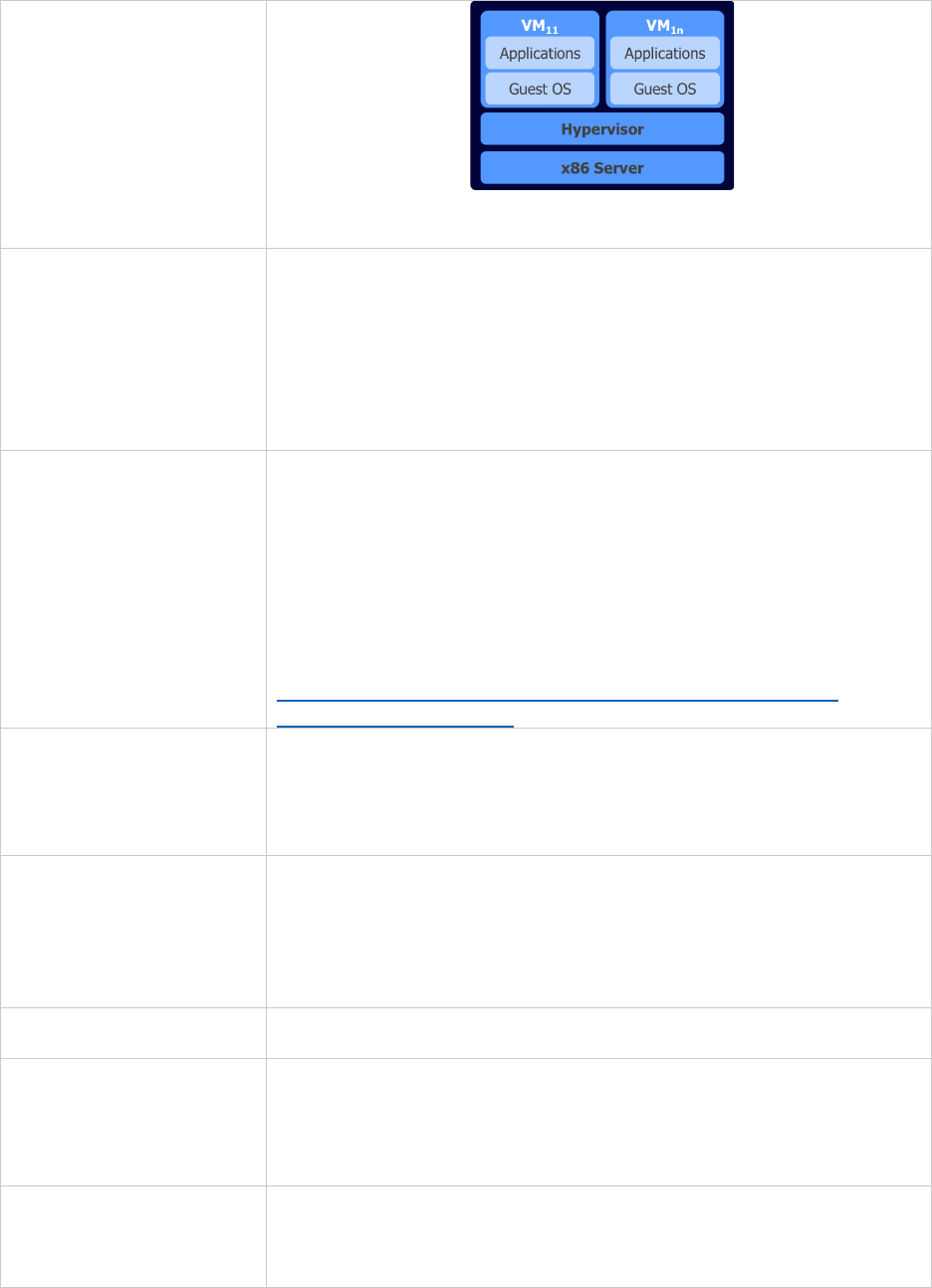
UNCLASSIFIED
40
Unclassified
Figure 16 Notional Hypervisor Construct
Image Management,
Software Image
Management,
Binary Image
Management,
Container Image
Management,
VM Image Management
The process of centralizing, organizing, distributing, and tracking
of software artifacts.
Immutable
infrastructure
An infrastructure paradigm in which servers are never modified
after they're deployed. If something needs to be updated, fixed, or
modified in any way, new servers built from a common image with
the appropriate changes are provisioned to replace the old ones.
After they're validated, they're put into use and the old ones are
decommissioned.
The benefits of an immutable infrastructure include more
consistency and reliability in your infrastructure and a simpler,
more predictable deployment process. (from:
https://www.digitalocean.com/community/tutorials/what-is-
immutable-infrastructure)
Infrastructure as Code
The management of infrastructure (networks, virtual machines,
load balancers, and connection topology) in a descriptive model,
using the same versioning that the DevSecOps team uses for
source code. Infrastructure as Code evolved to solve the problem
of environment drift in the release pipeline.
Kubernetes
An open-source system for automating deployment, scaling, and
management of containerized applications. It was originally
designed by Google and is now maintained by the CNCF. Many
vendors also provide their own branded Kubernetes. It works with
a range of container runtimes. Many cloud services offer a
Kubernetes-based platform as a service.
Lockdown
The closing or removal of weaknesses and vulnerabilities from
software.
Microservices
Microservices are both an architecture and an approach to
software development in which a monolith application is broken
down into a suite of loosely coupled independent services that can
be altered, updated, or taken down without affecting the rest of the
application.
Mission Application
Platform
The mission application platform is the underlying hosting
environment resources and capabilities, plus any mission program
enhanced capabilities that form the base upon which the mission
software application operates.

UNCLASSIFIED
41
Unclassified
Monitoring
Security Monitoring
The regular observation, recording, and presentation of activities.
Node
Cluster node
A node is a worker machine in CNCF Kubernetes. A node may be
a VM or physical machine, depending on the cluster. Each node
contains the services necessary to run pods and is managed by
the master components, including the node controller.
OCI
“An open governance structure for the express purpose of
creating open industry standards around container formats and
runtime” - https://www.opencontainers.org/
OCI Compliant
Container
Container image conforms with the OCI Image Specification.
OCI Compliant
Container Runtime
A container runtime is software that executes containers and
manages container images on a node. OCI compliant container
runtime must conform with the OCI Runtime Specification.
Orchestration
Automated configuration, coordination, and management.
Platform
A platform is a group of resources and capabilities that form a
base upon which other capabilities or services are built and
operated.
Pod
A group of containers that run on the same CNCF Kubernetes
worker node and share libraries and OS resources.
Provisioning
Instantiation, configuration, and management of software or the
environments that host or contain software.
Reporting
An account or statement describing an event.
Repository
A central place in which data is aggregated and maintained in an
organized way.
Resource
CPU, Memory, Disk, Networking
Scanning,
Security Scanning
The evaluation of software for cybersecurity weaknesses and
vulnerabilities.
Sidecar Container
Security Stack
A sidecar container security stack is a sidecar container(s) that
enhances the security capabilities of the main containers in the
same Pod.
Sidecar
A sidecar is a container used to extend or enhance the
functionality of an application container without strong coupling
between two. When using CNCF Kubernetes, a pod is composed
of one or more containers. A sidecar is a utility container in the
pod and its purpose is to support the main application container or
containers inside the same pod.
Telemetry
Capability to take measurements and collect and distribute the
data.
Test Coverage,
Code Coverage
Test coverage is a measure used to describe what percentage of
application code is exercised when a test suite runs. A higher
percentage indicates more source code executed during testing,
which suggests a lower chance of containing undetected bugs.
Virtual Machine (VM)
Emulates a physical computer in software. Several VMs can run
on the same physical device.
Virtual Network
Networks constructed of software-defined devices.
Virtual Storage
Storage constructed of software-defined devices.
